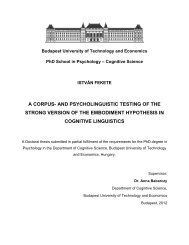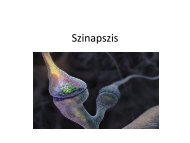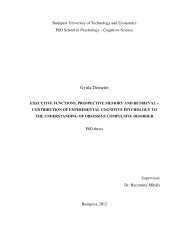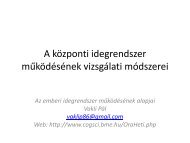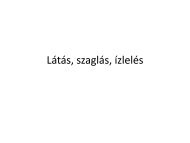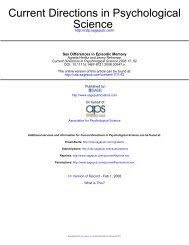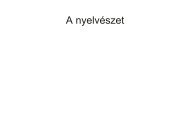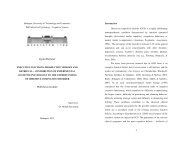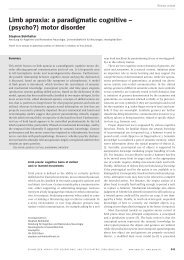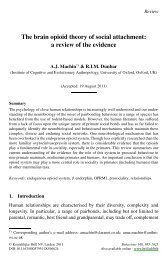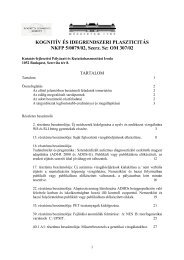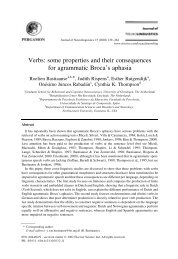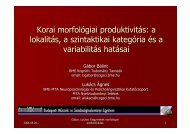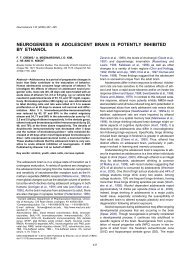Motoric response inhibition in finger movement and saccadic eye ...
Motoric response inhibition in finger movement and saccadic eye ...
Motoric response inhibition in finger movement and saccadic eye ...
You also want an ePaper? Increase the reach of your titles
YUMPU automatically turns print PDFs into web optimized ePapers that Google loves.
Abstract<br />
<strong>Motoric</strong> <strong>response</strong> <strong><strong>in</strong>hibition</strong> <strong>in</strong> ®nger <strong>movement</strong> <strong>and</strong> <strong>saccadic</strong> <strong>eye</strong><br />
<strong>movement</strong>: a comparative study<br />
Dennis Van 't Ent*, Patricia Apkarian<br />
Department of Physiology I, Medical Faculty, Erasmus University Rotterdam, PO Box 1738, 3000 DR Rotterdam, The Netherl<strong>and</strong>s<br />
Accepted 8 September 1998<br />
Objective: To study cortical potentials associated with suppression of <strong>in</strong>tended motoric actions.<br />
Methods: Electro-encephalographic activity was recorded <strong>in</strong> a Go/NoGo reaction time paradigm. Subjects viewed computer-generated<br />
pac<strong>in</strong>g stimuli, which provided <strong>in</strong>formation concern<strong>in</strong>g the time at which an imperative Go/NoGo signal occurred. A motoric <strong>response</strong> was<br />
required follow<strong>in</strong>g Go stimuli while motoric <strong>response</strong> <strong><strong>in</strong>hibition</strong> was required follow<strong>in</strong>g NoGo stimuli. To exam<strong>in</strong>e whether previously<br />
reported `Go/NoGo effects' on event related potential (ERP) components may be generalized across <strong>movement</strong> modalities, the present<br />
experimental paradigm was performed with either ®nger <strong>movement</strong> or <strong>saccadic</strong> <strong>eye</strong> <strong>movement</strong> as required motoric <strong>response</strong>.<br />
Results: For both <strong>movement</strong> modalities, comparable differences <strong>in</strong> the morphology, amplitude <strong>and</strong> scalp topography of ERP components<br />
were observed between Go trials, with proper <strong>movement</strong> execution, <strong>and</strong> NoGo trials, with complete suppression of motoric activity. In<br />
addition, for either <strong>movement</strong> modality a similar `error related negativity' (ERN) was found for NoGo trials <strong>in</strong> which motoric activity was<br />
present.<br />
Conclusions: The results of the present study suggest that cortical activity underly<strong>in</strong>g the Go/NoGo differences <strong>in</strong> ERP components<br />
represent general cortical process<strong>in</strong>g associated with detection <strong>and</strong>/or suppression of <strong>in</strong>appropriate <strong>response</strong> behaviour, <strong>in</strong>dependent of<br />
<strong>movement</strong> modality. q 1999 Elsevier Science Irel<strong>and</strong> Ltd. All rights reserved.<br />
Keywords: Saccadic <strong>eye</strong> <strong>movement</strong>; F<strong>in</strong>ger <strong>movement</strong>; Go/NoGo task; P300; N2; Error related negativity (ERN)<br />
1. Introduction<br />
Scalp recorded cortical activity associated with motoric<br />
<strong>response</strong> <strong><strong>in</strong>hibition</strong> can readily be exam<strong>in</strong>ed by compar<strong>in</strong>g<br />
event related potentials follow<strong>in</strong>g stimuli that either<br />
comm<strong>and</strong> or prohibit a speci®c motor <strong>response</strong>. For example,<br />
<strong>in</strong> a Go/NoGo reaction time paradigm, a pre-de®ned<br />
motoric <strong>response</strong> is required follow<strong>in</strong>g Go stimuli, while<br />
the <strong>response</strong> is to be withheld follow<strong>in</strong>g NoGo stimuli<br />
(Karl<strong>in</strong> et al., 1970). Several Go/NoGo studies report an<br />
enhancement <strong>in</strong> amplitude of the late positivity `P300',<br />
referred to also as `P3', on NoGo trials compared with Go<br />
trials (Karl<strong>in</strong> et al., 1970; Hillyard et al., 1976; Simson et al.,<br />
1977 ; Pfefferbaum et al., 1985; Kok, 1986; Pfefferbaum <strong>and</strong><br />
Ford, 1988; Jodo <strong>and</strong> Inoue, 1990; Roberts et al., 1994).<br />
Several of these studies (Karl<strong>in</strong> et al., 1970; Hillyard et<br />
al., 1976; Simson et al., 1977; Pfefferbaum et al., 1985;<br />
* Correspond<strong>in</strong>g author. MEG Centre KNAN, Academic Hospital, Free<br />
University Amsterdam, PO BOX 7057, 1007 MB Amsterdam, The Netherl<strong>and</strong>s.<br />
Tel.: 1 31-20-4440685; fax: 1 31-20-444816.<br />
E-mail address: d.vantent@azvu.nl (D. Van 't Ent)<br />
Cl<strong>in</strong>ical Neurophysiology 110 (1999) 1058±1072<br />
1388-2457/99/$ - see front matter q 1999 Elsevier Science Irel<strong>and</strong> Ltd. All rights reserved.<br />
PII: S1388-2457(98)00036-4<br />
Pfefferbaum <strong>and</strong> Ford, 1988; Roberts et al., 1994) also<br />
report that component `P300' follow<strong>in</strong>g NoGo stimuli is<br />
most pronounced at frontal-central scalp sites, while the<br />
`P300' elicited by Go stimuli dom<strong>in</strong>ates at parietal sites.<br />
Latency of component `P300' is also generally found<br />
prolonged on NoGo trials (Simson et al., 1977; Pfefferbaum<br />
et al., 1985; Pfefferbaum <strong>and</strong> Ford, 1988; Roberts et al.,<br />
1994). The Go/NoGo effect on component `P300' has<br />
been associated with cortical process<strong>in</strong>g related to motoric<br />
<strong>response</strong> <strong><strong>in</strong>hibition</strong> (Karl<strong>in</strong> et al., 1970; Roberts et al.,<br />
1994).<br />
Concomitant to the `P300' Go/NoGo effect, several<br />
studies report a negative component, typically labelled<br />
N2, which is most pronounced follow<strong>in</strong>g NoGo stimuli<br />
(Simson et al., 1977; Pfefferbaum et al., 1985; Kok, 1986;<br />
Gemba <strong>and</strong> Sasaki, 1989; Jodo <strong>and</strong> Inoue, 1990; Jodo <strong>and</strong><br />
Kayama, 1992; Eimer, 1993; Naito <strong>and</strong> Matsumura, 1994a;<br />
Naito <strong>and</strong> Matsumura, 1994b; Falkenste<strong>in</strong> et al., 1995;<br />
Naito <strong>and</strong> Matsumura, 1996). Component N2 is reported<br />
as maximal at frontal scalp sites with a latency of about<br />
200±300 ms relative to the onset of the Go/NoGo stimulus.<br />
As for the `P300' Go/NoGo effect, the N2 Go/NoGo effect<br />
CLINPH 98655
Fig. 1. Visual stimulus consist<strong>in</strong>g of a computer-drawn half-circle.<br />
Depicted are onset of the computer animation (S1) at 23 s, <strong>in</strong>itial half of<br />
the computer sketch at 21.5 s <strong>and</strong> ®nal completion of the animation at 0 s.<br />
Subject is required to ma<strong>in</strong>ta<strong>in</strong> central ®xation dur<strong>in</strong>g the entire computer<br />
animation. The <strong>in</strong>itial circle ®ll colour is grey, but at 100 ms preced<strong>in</strong>g<br />
stimulus completion (S2), the ®nal circle segment is drawn <strong>in</strong> green or red,<br />
with 50% probability of either colour occurr<strong>in</strong>g. Subjects are <strong>in</strong>structed to<br />
<strong>in</strong>itiate (green) or to withhold (red) a pre-de®ned motor <strong>response</strong>. Note the<br />
two <strong>saccadic</strong> targets displayed simultaneously right <strong>and</strong> left of central<br />
®xation, along the horizontal meridian.<br />
has been related to <strong><strong>in</strong>hibition</strong> of <strong>in</strong>appropriately <strong>in</strong>itiated<br />
<strong>response</strong>s.<br />
An additional negative component is also observed<br />
dur<strong>in</strong>g NoGo `error' trials, i.e., NoGo trials <strong>in</strong> which the<br />
motoric <strong>response</strong> is erroneously executed (Naito <strong>and</strong> Matsumura,<br />
1994b; Falkenste<strong>in</strong> et al., 1995; Kopp et al., 1996;<br />
Scheffers et al., 1996). This component has been labelled<br />
`error-related negativity' (ERN) (Gehr<strong>in</strong>g et al., 1993) or<br />
`error negativity' (Ne) (Falkenste<strong>in</strong> et al., 1991). In general,<br />
amplitude of the ERN/Ne is reported to be enhanced<br />
compared with component N2 derived from `correct'<br />
NoGo trials (Naito <strong>and</strong> Matsumura, 1994b). However,<br />
morphology, latency <strong>and</strong> scalp topography of the N2 <strong>and</strong><br />
ERN/Ne are reported to be comparable (Falkenste<strong>in</strong> et al.,<br />
1995). Related studies suggest that the ERN/N e on error<br />
trials may be associated with error-process<strong>in</strong>g mechanisms<br />
(Falkenste<strong>in</strong> et al., 1991; Gehr<strong>in</strong>g et al., 1993; Scheffers et<br />
al., 1996).<br />
In a recent study by Van `t Ent <strong>and</strong> Apkarian (1998),<br />
cortical activity was recorded <strong>in</strong> a cont<strong>in</strong>gent negative variation<br />
(CNV) paradigm. Computer-generated pac<strong>in</strong>g stimuli<br />
were presented that also provided <strong>in</strong>formation regard<strong>in</strong>g the<br />
time at which a Go/NoGo stimulus appeared. In the previous<br />
study cited, analysis was restricted to cortical activity<br />
recorded on `Go' trials with concentration on recorded<br />
event related potentials (ERPs) dur<strong>in</strong>g the time <strong>in</strong>terval<br />
between onset of the pac<strong>in</strong>g stimulus <strong>and</strong> onset of the<br />
imperative Go/NoGo stimulus. In contrast, the present<br />
study concentrates primarily on ERPs recorded follow<strong>in</strong>g<br />
the imperative signal. In particular, cortical <strong>response</strong><br />
pro®les follow<strong>in</strong>g Go <strong>and</strong> NoGo stimuli were compared,<br />
to exam<strong>in</strong>e amplitude, latency <strong>and</strong> scalp topography of<br />
ERP components associated with suppression of <strong>in</strong>tended<br />
D. Van 't Ent, P. Apkarian / Cl<strong>in</strong>ical Neurophysiology 110 (1999) 1058±1072 1059<br />
motoric actions. Generally, previous Go/NoGo studies<br />
focused on suppression of <strong>in</strong>tended ®nger <strong>movement</strong><br />
(Jodo <strong>and</strong> Inoue, 1990; Roberts et al., 1994; Falkenste<strong>in</strong> et<br />
al., 1995). However, <strong>in</strong> the present study, cortical activity<br />
was evaluated dur<strong>in</strong>g performance of the Go/NoGo test<br />
paradigm with either ®nger <strong>movement</strong> or <strong>saccadic</strong> <strong>eye</strong><br />
<strong>movement</strong> as required motoric action. Event related potentials<br />
follow<strong>in</strong>g Go <strong>and</strong> NoGo stimuli for ®nger <strong>and</strong> <strong>eye</strong><br />
<strong>movement</strong> conditions were compared <strong>in</strong> order to exam<strong>in</strong>e<br />
whether the `Go/NoGo effects' on ERP components as<br />
reported <strong>in</strong> previous studies (Naito <strong>and</strong> Matsumura,<br />
1994a; Naito <strong>and</strong> Matsumura, 1994b; Roberts et al., 1994;<br />
Kopp et al., 1996; Scheffers et al., 1996) are characteristic<br />
for h<strong>and</strong> <strong>movement</strong>, or whether comparable effects are<br />
found across <strong>movement</strong> modalities.<br />
Results of the present study <strong>in</strong>dicate that event-related<br />
cortical <strong>response</strong> pro®les as recorded <strong>in</strong> a Go/NoGo paradigm,<br />
<strong>in</strong>clud<strong>in</strong>g the above-mentioned P300 (P3) <strong>and</strong> N2 Go/<br />
NoGo differences as well as component ERN/Ne from<br />
NoGo error trials, are comparable for ®nger <strong>movement</strong><br />
<strong>and</strong> <strong>saccadic</strong> <strong>eye</strong> <strong>movement</strong>. The latter ®nd<strong>in</strong>g suggests<br />
that the observed `Go/NoGo effects' on ERP components<br />
re¯ect primarily non-effector speci®c cortical process<strong>in</strong>g<br />
associated with error-related process<strong>in</strong>g <strong>and</strong>/or suppression<br />
of <strong>in</strong>appropriate <strong>response</strong> tendencies.<br />
2. Methods <strong>and</strong> materials<br />
Experimental protocol <strong>and</strong> procedures for record<strong>in</strong>g electro-physiological<br />
activity are brie¯y described; for more<br />
detail, see Van `t Ent <strong>and</strong> Apkarian (1998).<br />
2.1. Subjects<br />
A total of 10 right-h<strong>and</strong>ed subjects participated <strong>in</strong> the<br />
study, <strong>in</strong>clud<strong>in</strong>g 7 males <strong>and</strong> 3 females (age range 22±51,<br />
mean age 31.3 years). Informed consent was obta<strong>in</strong>ed from<br />
each subject; experimental protocols were approved by the<br />
ethics committee of the Erasmus University Medical<br />
Faculty.<br />
2.2. Stimulus <strong>and</strong> procedure<br />
Subjects sat <strong>in</strong> a comfortable chair, with head support,<br />
fac<strong>in</strong>g a computer screen positioned at a distance of 81 cm.<br />
In the centre of the screen a ®xation target (radius 0.158) was<br />
displayed. Dur<strong>in</strong>g a cartoon animation of 3 s duration, the<br />
left half of a circle (radius 4.58), centred on the ®xation<br />
po<strong>in</strong>t, was drawn (Fig. 1). Subjects were <strong>in</strong>structed to ma<strong>in</strong>ta<strong>in</strong><br />
central ®xation dur<strong>in</strong>g the computer animation. At 100<br />
ms prior to stimulus completion, a change <strong>in</strong> circle ®ll<br />
colour from grey to green or red, either colour occurr<strong>in</strong>g<br />
with 50% probability, signalled whether subjects were to<br />
<strong>in</strong>itiate (green) or withhold (red) a given motor <strong>response</strong>.<br />
At 2.5 s follow<strong>in</strong>g each trial, visual feedback was provided<br />
<strong>in</strong>dicat<strong>in</strong>g whether or not subject reaction time was with<strong>in</strong>
1060<br />
Fig. 2. Stimulus synchronized ERPs on Go trials (bold traces) <strong>and</strong> `correct'<br />
NoGo trials (th<strong>in</strong> traces), for ®nger <strong>movement</strong> conditions. Upper: right<br />
<strong>in</strong>dex ®nger extension; lower: left <strong>in</strong>dex ®nger extension. Traces are<br />
depicted <strong>in</strong> order of the employed electrode montage. Computer animation<br />
onset (S1) <strong>and</strong> imperative colour change onset (S2) are <strong>in</strong>dicated below the<br />
occipital traces. Range of <strong>movement</strong> onset for motor <strong>response</strong>s on Go trials<br />
is illustrated by the small solid horizontal bars. An enhancement of component<br />
P3, follow<strong>in</strong>g the imperative stimulus, is evident on `correct' NoGo<br />
trials compared with Go trials, especially at frontal (F 0 3, FCz, F 0 4) <strong>and</strong><br />
central (C 0 3, Cz, C 0 4, C 00 3, C 00 4) electrode sites. In addition, for `correct'<br />
NoGo trials follow<strong>in</strong>g S2, a small negative de¯ection is evident on the<br />
<strong>in</strong>itial positive-go<strong>in</strong>g limb of component P3. This negative component,<br />
labelled N2, is also most pronounced at frontal-central scalp sites. The<br />
averaged ERPs on Go trials are derived from Van `t Ent <strong>and</strong> Apkarian<br />
(1998).<br />
200 ms follow<strong>in</strong>g imperative colour change (S2) onset. The<br />
time <strong>in</strong>terval between subsequent trials was r<strong>and</strong>omized<br />
between 4 <strong>and</strong> 10 s.<br />
The experimental protocol was performed with 4 <strong>movement</strong><br />
conditions conducted <strong>in</strong> separate test sessions, <strong>in</strong>clud<strong>in</strong>g<br />
right ®nger extension, left ®nger extension, rightward<br />
<strong>saccadic</strong> <strong>eye</strong> <strong>movement</strong> <strong>and</strong> leftward <strong>saccadic</strong> <strong>eye</strong> <strong>movement</strong>.<br />
Each session consisted of 7 blocks of 3 m<strong>in</strong> each;<br />
session order was counter-balanced across subjects. In the<br />
<strong>eye</strong> <strong>movement</strong> conditions, two small ®lled circles (radius<br />
0.38) that were presented permanently at 8.58 left <strong>and</strong> right<br />
from the central ®xation po<strong>in</strong>t served as <strong>saccadic</strong> targets.<br />
2.3. Record<strong>in</strong>g<br />
Electro-encephalographic (EEG) activity was recorded<br />
D. Van 't Ent, P. Apkarian / Cl<strong>in</strong>ical Neurophysiology 110 (1999) 1058±1072<br />
from 12 scalp sites, referred to l<strong>in</strong>ked earlobe electrodes.<br />
Electrodes Cz <strong>and</strong> Pz were positioned accord<strong>in</strong>g to the st<strong>and</strong>ard<br />
10±20 system (Jasper, 1958). Site FCz was positioned<br />
mid-way between scalp sites Cz <strong>and</strong> Fz of the 10±20 system<br />
(Lang et al., 1984; Naito <strong>and</strong> Matsumura, 1994a) <strong>and</strong> electrodes<br />
C 0 3, C 0 4 <strong>and</strong> C 00 3, C 00 4 were placed, respectively, 1<br />
cm anterior <strong>and</strong> 2 cm posterior to l<strong>and</strong>marks C3 <strong>and</strong> C4 of<br />
the 10±20 system (GruÈnewald-Zuberbier et al., 1981); sites<br />
F 0 3 <strong>and</strong> F 0 4 were located 1 cm lateral <strong>and</strong> 2 cm anterior to<br />
C 0 3, C 0 4 (Sweeney et al., 1996). F<strong>in</strong>ally, sites O 0 z, O 0 1 <strong>and</strong><br />
O 0 2 were positioned 1 cm above the <strong>in</strong>ion on the mid-l<strong>in</strong>e<br />
(O 0 z) <strong>and</strong> at 5 cm left (O 0 1) <strong>and</strong> right (O 0 2) of the mid-l<strong>in</strong>e<br />
(Hard<strong>in</strong>g et al., 1996). Electro-myographic activity (EMG)<br />
was recorded from two electrode pairs cover<strong>in</strong>g left <strong>and</strong><br />
right <strong>in</strong>dex ®nger extensor muscles. Electro-oculography<br />
(EOG) was recorded, <strong>in</strong> bipolar derivation, from electrodes<br />
placed at the outer canthi of both <strong>eye</strong>s. To control for <strong>eye</strong><br />
bl<strong>in</strong>ks <strong>and</strong> vertical <strong>eye</strong> <strong>movement</strong>s, an additional electrode<br />
was positioned above the nasion <strong>and</strong> referred to the electrode<br />
at the right outer canthus. EEG <strong>and</strong> EOG activity were<br />
ampli®ed with a b<strong>and</strong>-pass ®lter sett<strong>in</strong>g of 0.032±100 Hz;<br />
EMG was high-pass ®ltered at 5.2 Hz. Analog to digital<br />
conversion was performed at 256 Hz.<br />
2.4. Data analysis<br />
2.4.1. <strong>Motoric</strong> <strong>response</strong> latency<br />
For each subject, latencies of motor related activity<br />
follow<strong>in</strong>g Go stimuli <strong>and</strong> latencies of erroneously executed<br />
motor activity follow<strong>in</strong>g NoGo stimuli were determ<strong>in</strong>ed.<br />
<strong>Motoric</strong> <strong>response</strong> latency was de®ned as the time <strong>in</strong>terval<br />
between onset of the imperative change <strong>in</strong> stimulus colour<br />
<strong>and</strong> onset of motoric <strong>response</strong> activity. <strong>Motoric</strong> <strong>response</strong><br />
onset was determ<strong>in</strong>ed, off-l<strong>in</strong>e, by superimpos<strong>in</strong>g a vertical<br />
hairl<strong>in</strong>e cursor on the recorded EMG or EOG traces for<br />
®nger <strong>and</strong> <strong>eye</strong> <strong>movement</strong> conditions, respectively (Barrett<br />
et al., 1985). <strong>Motoric</strong> <strong>response</strong> latency was evaluated statistically<br />
by means of repeated measures analysis of variance<br />
(ANOVA). The analysis was performed with with<strong>in</strong>-subject<br />
variables Go/NoGo (Go trials vs. NoGo trials), Movement<br />
Modality (®nger extension vs. <strong>eye</strong> <strong>movement</strong>) <strong>and</strong> Movement<br />
Side (right vs. left ®nger extension, rightward vs. leftward<br />
<strong>eye</strong> <strong>movement</strong>).<br />
2.4.2. Event related potentials (ERPs)<br />
For each subject <strong>and</strong> <strong>movement</strong> condition, the stimulus,<br />
as well as <strong>response</strong> synchronized averaged ERP pro®les<br />
were constructed for Go <strong>and</strong> NoGo trials. Trials with artefacts<br />
<strong>in</strong> the ERPs, <strong>in</strong>clud<strong>in</strong>g <strong>eye</strong> <strong>movement</strong> artefacts, ampli-<br />
®er clipp<strong>in</strong>g <strong>and</strong> extensive EMG activity <strong>and</strong>/or electrophysiological<br />
drift, were rejected. Artefacts from required<br />
saccades <strong>in</strong> the <strong>eye</strong> <strong>movement</strong> conditions were corrected by<br />
means of a subtraction procedure described previously (Van<br />
`t Ent <strong>and</strong> Apkarian, 1998). Averages subtended from 3.25 s<br />
preced<strong>in</strong>g to 1 s follow<strong>in</strong>g stimulus completion or <strong>movement</strong><br />
onset. In the stimulus aligned epochs the ®rst 250 ms,
<strong>and</strong> <strong>in</strong> the <strong>response</strong> aligned epochs the ®rst 70 ms of each<br />
epoch were used as pre-stimulus basel<strong>in</strong>e. NoGo trials were<br />
de®ned either as `correct' or `<strong>in</strong>correct.' Trials were designated<br />
`correct' when either <strong>in</strong> the EMG trace for the ®nger<br />
extension conditions or <strong>in</strong> the horizontal EOG trace for the<br />
<strong>eye</strong> <strong>movement</strong> conditions, motor related activity was<br />
completely absent. When motoric activity was evident,<br />
trials were de®ned as `<strong>in</strong>correct.' In the averaged ERP<br />
pro®les for Go <strong>and</strong> `<strong>in</strong>correct' NoGo trials, trials were<br />
<strong>in</strong>cluded when motoric <strong>response</strong> latency was with<strong>in</strong> one<br />
st<strong>and</strong>ard deviation of mean motoric <strong>response</strong> latency on<br />
Go trials. For both <strong>movement</strong> modalities, mean motoric<br />
<strong>response</strong> latency was obta<strong>in</strong>ed by averag<strong>in</strong>g latency values<br />
of motoric <strong>response</strong> activity on Go trials across subjects <strong>and</strong><br />
across left <strong>and</strong> right side <strong>movement</strong> conditions. No latency<br />
limits were imposed for `correct' NoGo trials.<br />
Statistical analysis focused on ERP components follow<strong>in</strong>g<br />
the imperative Go/NoGo stimulus, <strong>in</strong>clud<strong>in</strong>g positive<br />
component, P3, negative component, N2, <strong>and</strong> the `error<br />
related negativity', ERN (Gehr<strong>in</strong>g et al., 1993). Components<br />
N2 <strong>and</strong> ERN were evident as negative de¯ections<br />
on the <strong>in</strong>itial positive go<strong>in</strong>g limb of component P3, on<br />
`correct' <strong>and</strong> `<strong>in</strong>correct' NoGo trials, respectively (Fig. 4).<br />
For each subject, determ<strong>in</strong>ation of latency values of ERP<br />
components, from the averaged cortical activity recorded at<br />
electrode site Cz, was facilitated by superimposed vertical<br />
cursor hairl<strong>in</strong>es. Component latencies were measured relative<br />
to imperative stimulus (S2) onset. ERP components<br />
analyzed were rather narrow. Therefore, component amplitudes<br />
were calculated by averag<strong>in</strong>g ERP data samples also<br />
with<strong>in</strong> a narrow time <strong>in</strong>terval, subtend<strong>in</strong>g 25 ms centred on<br />
peak latency (the latency at which maximum amplitude was<br />
recorded). Amplitude of component P3 was measured relative<br />
to maximum amplitude of the cont<strong>in</strong>gent negative<br />
variation (CNV) slow waveform (Grey Walter et al.,<br />
1964), recorded across the time <strong>in</strong>terval between computer<br />
animation onset <strong>and</strong> imperative stimulus onset. As the CNV<br />
maximum was somewhat broader, CNV amplitude was<br />
calculated by averag<strong>in</strong>g ERP data samples across a wider<br />
time <strong>in</strong>terval, subtend<strong>in</strong>g 160 ms centred on peak CNV<br />
latency. The broader CNV time <strong>in</strong>terval was selected to<br />
improve accuracy of the amplitude estimate. Amplitude<br />
values of components N2 <strong>and</strong> ERN were measured relative<br />
to mean ERP amplitude across a 25 ms <strong>in</strong>terval, centred on<br />
the latency at which a negative de¯ection appears on the<br />
positive go<strong>in</strong>g limb of component P3. Latency <strong>and</strong> amplitude<br />
values were evaluated statistically by means of<br />
repeated measures ANOVA. For component P3, analysis<br />
of latency values <strong>in</strong>cluded with<strong>in</strong>-subject variables Movement<br />
Modality (®nger extension vs. <strong>eye</strong> <strong>movement</strong>) <strong>and</strong><br />
variable Movement Side (right vs. left ®nger extension,<br />
rightward vs. leftward <strong>eye</strong> <strong>movement</strong>). In addition, variable<br />
Go/NoGo (Go trials vs. `correct' NoGo trials) or variable<br />
Correct vs. Incorrect (`correct' NoGo trials vs. `<strong>in</strong>correct'<br />
NoGo trials) was <strong>in</strong>cluded to compare latency values of<br />
ERP components between Go <strong>and</strong> `correct' NoGo trials,<br />
D. Van 't Ent, P. Apkarian / Cl<strong>in</strong>ical Neurophysiology 110 (1999) 1058±1072 1061<br />
or between `correct' <strong>and</strong> `<strong>in</strong>correct' NoGo trials. Variable<br />
Movement Side was omitted for analysis of ERPs averaged<br />
across right <strong>and</strong> left side <strong>movement</strong> conditions. Latency<br />
values of components N2 <strong>and</strong> ERN, for `correct' <strong>and</strong> `<strong>in</strong>correct'<br />
NoGo trials, were evaluated <strong>in</strong> a s<strong>in</strong>gle repeated<br />
measures design with with<strong>in</strong>-subject variables N2 vs. ERN<br />
(N2 latency vs. ERN latency) <strong>and</strong> Movement Modality<br />
(®nger extension vs. <strong>eye</strong> <strong>movement</strong>). For analysis of<br />
component amplitudes, similar statistical pro®les were<br />
used. With<strong>in</strong>-subject variable Electrode (sites FCz, Cz, Pz<br />
<strong>and</strong> O 0 z) was added to evaluate mid-l<strong>in</strong>e amplitude topography.<br />
Bonferroni's correction method was applied to<br />
allow for multiple comparisons <strong>in</strong> the statistical analyses.<br />
When applicable, degrees of freedom were adjusted accord<strong>in</strong>g<br />
to Geisser <strong>and</strong> Greenhouse (1958). In the present study,<br />
uncorrected degrees of freedom are reported to facilitate<br />
<strong>in</strong>terpretation of the statistical design.<br />
2.4.3. Error size<br />
<strong>Motoric</strong> actions on `<strong>in</strong>correct' NoGo trials were classi®ed<br />
as either small or large errors. For ®nger extension, electromyographic<br />
(EMG) activity was <strong>in</strong>tegrated (time constant:<br />
0.05 s) over a 200 ms time <strong>in</strong>terval start<strong>in</strong>g at the onset of<br />
<strong>response</strong> related EMG activity. <strong>Motoric</strong> actions were<br />
de®ned as small errors when EMG rema<strong>in</strong>ed below 20%<br />
of the median <strong>in</strong>tegrated EMG activity for motoric actions<br />
on Go trials. Motor <strong>response</strong>s were classi®ed as large errors<br />
when <strong>response</strong> related EMG exceeded the 20% threshold.<br />
For <strong>eye</strong> <strong>movement</strong>, saccade amplitude was determ<strong>in</strong>ed by<br />
calculat<strong>in</strong>g the average electro-oculographic (EOG) activity<br />
over a time <strong>in</strong>terval, subtend<strong>in</strong>g from saccade offset to 80<br />
ms follow<strong>in</strong>g saccade offset. Saccade amplitude was<br />
measured relative to the mean EOG activity across the<br />
®rst 500 ms preced<strong>in</strong>g saccade onset. In general, <strong>saccadic</strong><br />
<strong>eye</strong> <strong>movement</strong>s on NoGo trials ceased while close to the<br />
saccade target; only a few saccades were substantially hypometric.<br />
As such, a higher percentage of EOG activity dur<strong>in</strong>g<br />
<strong>eye</strong> <strong>movement</strong> Go trials was employed to classify saccades<br />
as small or large errors. When EOG amplitude on NoGo<br />
trials was below 85% of the median EOG de¯ection on<br />
Go trials, saccades were de®ned as small errors. Saccades<br />
with amplitude beyond the 85% limit were speci®ed as large<br />
errors. Statistical analysis, by means of repeated measures<br />
ANOVA, was performed on the amplitude of component<br />
ERN for `<strong>in</strong>correct' NoGo trials with small errors <strong>and</strong> for<br />
`<strong>in</strong>correct' NoGo trials with large errors. To facilitate<br />
comparison, analysis also <strong>in</strong>cluded the amplitude of component<br />
N2 on `correct' NoGo trials with no errors. With<strong>in</strong>subject<br />
variables <strong>in</strong>cluded Movement Modality (®nger<br />
extension vs. <strong>eye</strong> <strong>movement</strong>), Error Size (3 levels: `correct'<br />
NoGo trials, `<strong>in</strong>correct' NoGo trials with small errors,<br />
`<strong>in</strong>correct' NoGo trials with large errors) <strong>and</strong> Electrode<br />
(mid-l<strong>in</strong>e electrode sites FCz, Cz <strong>and</strong> Pz).<br />
In addition, averaged ERP pro®les for `correct' NoGo<br />
trials were subtracted from the cortical <strong>response</strong> pro®les<br />
recorded for `<strong>in</strong>correct' NoGo trials with small <strong>and</strong> large
1062<br />
Table 1<br />
Mean motoric <strong>response</strong> latency (ms) ^ SEM a<br />
errors. Mean size of the amplitude difference between<br />
`correct <strong>and</strong> `<strong>in</strong>correct' NoGo trials was calculated across<br />
a 40 ms time <strong>in</strong>terval centred on maximum amplitude of the<br />
difference waveform. Mean values were measured relative<br />
to the average amplitude across a 250 ms <strong>in</strong>terval preced<strong>in</strong>g<br />
onset of the amplitude difference. Calculated difference<br />
values were evaluated statistically by repeated measures<br />
ANOVA, with with<strong>in</strong>-subject variables Movement Modality<br />
(®nger extension vs. <strong>eye</strong> <strong>movement</strong>), Error Size (large<br />
errors vs. small errors) <strong>and</strong> Electrode (FCz, Cz, Pz).<br />
2.4.4. Stimulus versus <strong>response</strong> aligned averag<strong>in</strong>g<br />
To exam<strong>in</strong>e whether component ERN is time-locked<br />
more closely to imperative stimulus onset or to onset of<br />
motoric <strong>response</strong> activity, stimulus aligned <strong>and</strong> motoric<br />
<strong>response</strong> aligned cortical <strong>response</strong> pro®les, averaged across<br />
`<strong>in</strong>correct' NoGo trials, were compared. Peak amplitude<br />
values of component ERN <strong>in</strong> the stimulus <strong>and</strong> <strong>response</strong><br />
aligned waveforms at mid-l<strong>in</strong>e electrode sites FCz, Cz <strong>and</strong><br />
Pz were exam<strong>in</strong>ed by repeated measures ANOVA, with<br />
Alignment (stimulus vs. <strong>response</strong> synchronized averag<strong>in</strong>g),<br />
Movement Modality (®nger vs. <strong>eye</strong> <strong>movement</strong>) <strong>and</strong> Electrode<br />
as with<strong>in</strong>-subject variables.<br />
For additional analysis, separate averages were<br />
constructed for `<strong>in</strong>correct' NoGo trials with early <strong>and</strong> late<br />
onset of motoric activity, respectively. It was hypothesized<br />
that if component ERN is time-locked more closely to the<br />
imperative stimulus, ERN onset <strong>and</strong> peak latency would be<br />
comparable across trials with early <strong>and</strong> late motoric<br />
<strong>response</strong> onset <strong>in</strong> the stimulus aligned averages. Component<br />
ERN would occur earlier on trials with late onset of motoric<br />
activity <strong>in</strong> the <strong>response</strong> locked averages. In contrast, if<br />
component ERN is time-locked more closely to motoric<br />
<strong>response</strong> onset, the ERN would appear at a comparable<br />
latency <strong>in</strong> the <strong>response</strong> synchronized averages <strong>and</strong> would<br />
occur earlier on trials with early onset of motoric activity <strong>in</strong><br />
the stimulus synchronized averages. <strong>Motoric</strong> <strong>response</strong><br />
latency was classi®ed as early or late when onset of motoric<br />
activity either preceded or followed median motoric<br />
<strong>response</strong> latency. For both <strong>movement</strong> modalities, median<br />
<strong>response</strong> latency was determ<strong>in</strong>ed from the set of motoric<br />
<strong>response</strong> latencies measured on `<strong>in</strong>correct' NoGo trials,<br />
across subjects <strong>and</strong> across right <strong>and</strong> left side <strong>movement</strong><br />
conditions. Statistical analysis of ERN latency values, by<br />
means of repeated measures ANOVA, was performed separately<br />
for stimulus <strong>and</strong> <strong>response</strong> synchronized averages.<br />
With<strong>in</strong>-subjects variables <strong>in</strong>cluded <strong>Motoric</strong> Response<br />
D. Van 't Ent, P. Apkarian / Cl<strong>in</strong>ical Neurophysiology 110 (1999) 1058±1072<br />
Right ®nger extension Left ®nger extension Saccades rightward Saccades leftward<br />
Go 179 ^ 23 167 ^ 29 211 ^ 22 209 ^ 25<br />
Incorrect NoGo 147 ^ 20 139 ^ 28 194 ^ 36 192 ^ 38<br />
a<br />
Mean motoric <strong>response</strong> latencies (^ st<strong>and</strong>ard error of the mean) on Go <strong>and</strong> `<strong>in</strong>correct' NoGo trials for each <strong>movement</strong> condition. Latency data for motoric<br />
activity on Go trials have been adapted from Van `t Ent <strong>and</strong> Apkarian (1998).<br />
Latency (early vs. late motoric <strong>response</strong> onset) <strong>and</strong> Movement<br />
Modality (®nger vs. <strong>eye</strong> <strong>movement</strong>).<br />
2.4.5. Lateralized read<strong>in</strong>ess potential (LRP)<br />
Motor related <strong>in</strong>ter-hemispheric amplitude lateralization<br />
was assessed by means of the lateralized read<strong>in</strong>ess potential<br />
(LRP) measure derived from stimulus synchronized ERPs<br />
(De Jong et al., 1988; Gratton et al., 1988). For statistical<br />
evaluation of <strong>in</strong>ter-hemispheric amplitude differences <strong>in</strong> the<br />
LRP, 3 contiguous 100 ms time w<strong>in</strong>dows were de®ned<br />
across a time <strong>in</strong>terval subtend<strong>in</strong>g from 100 ms follow<strong>in</strong>g<br />
stimulus offset (t ˆ 100 ms) to 400 ms follow<strong>in</strong>g stimulus<br />
offset (t ˆ 400 ms). Mean LRP values <strong>in</strong> each <strong>in</strong>dividual<br />
time w<strong>in</strong>dow were calculated for every subject <strong>and</strong> were<br />
exam<strong>in</strong>ed by means of Wilcoxon's test of paired differences.<br />
To account for multiple comparisons, signi®cant<br />
<strong>in</strong>ter-hemispheric asymmetry was assumed only when<br />
Wilcoxon's probability level was below P ˆ 0:01.<br />
3. Results<br />
3.1. <strong>Motoric</strong> <strong>response</strong> latency<br />
Onset latencies for motoric activity on Go trials <strong>and</strong> error<br />
<strong>response</strong>s on `<strong>in</strong>correct' NoGo trials, averaged across mean<br />
motoric <strong>response</strong> latencies for each <strong>in</strong>dividual subject, are<br />
listed <strong>in</strong> Table 1. Mean motoric <strong>response</strong> latency <strong>in</strong> the <strong>eye</strong><br />
<strong>movement</strong> tasks was signi®cantly longer than mean<br />
<strong>response</strong> latency <strong>in</strong> the ®nger extension tasks (variable<br />
Movement Modality; F…1; 9† ˆ52:41, P , 0:001). Furthermore,<br />
for both <strong>movement</strong> modalities, reaction times were<br />
shorter on `<strong>in</strong>correct' NoGo trials compared with Go trials<br />
(variable Go/NoGo: F…1; 9† ˆ18:50, P ˆ 0:002; <strong>in</strong>teraction<br />
Go/NoGo by Movement Modality: not signi®cant). No<br />
signi®cant differences were found for mean motoric<br />
<strong>response</strong> latency of right compared with left ®nger extensions<br />
or for mean <strong>response</strong> latency of rightward compared<br />
with leftward saccades.<br />
3.2. Event related potentials<br />
For Go <strong>and</strong> `<strong>in</strong>correct' NoGo averages, trials were<br />
<strong>in</strong>cluded when motoric <strong>response</strong> latency was with<strong>in</strong><br />
170:8 ^ 60:0 ms (latency range: 110.8±230.8 ms) for ®nger<br />
<strong>movement</strong> <strong>and</strong> with<strong>in</strong> 209:9 ^ 60:2 ms (latency range:<br />
149.7±270.1 ms) for <strong>saccadic</strong> <strong>eye</strong> <strong>movement</strong> (latency <strong>in</strong>tervals<br />
are derived from Van `t Ent <strong>and</strong> Apkarian, 1998). For
Fig. 3. Stimulus synchronized ERPs on Go trials (bold traces) <strong>and</strong> `correct'<br />
NoGo trials (th<strong>in</strong> traces) for <strong>eye</strong> <strong>movement</strong> conditions. Upper: rightward<br />
<strong>saccadic</strong> <strong>eye</strong> <strong>movement</strong>; lower: leftward <strong>saccadic</strong> <strong>eye</strong> <strong>movement</strong>. See also<br />
Figure legend 2 for more detail. As with ®nger <strong>movement</strong> (Fig. 2), component<br />
P3 follow<strong>in</strong>g the imperative stimulus (S2) is enhanced on `correct'<br />
NoGo trials compared with Go trials, particularly at frontal-central electrode<br />
sites. On `correct' NoGo trials, a negative de¯ection N2 on the<br />
descend<strong>in</strong>g limb of component P3 also is evident. Averaged cortical activity<br />
across Go trials are derived from Van `t Ent <strong>and</strong> Apkarian (1998).<br />
each subject <strong>and</strong> <strong>movement</strong> condition, on average 40 Go<br />
<strong>and</strong> 40 NoGo trials were selected. About 30% of the NoGo<br />
trials were labelled `<strong>in</strong>correct.'<br />
3.2.1. Go trials/`correct' NoGo trials<br />
Stimulus aligned ERPs, averaged across subjects, on Go<br />
trials (bold traces) <strong>and</strong> `correct' NoGo trials (th<strong>in</strong> l<strong>in</strong>ed<br />
traces) are depicted <strong>in</strong> Fig. 2 <strong>and</strong> Fig. 3. ERP components<br />
discernible <strong>in</strong> the cortical activity recorded dur<strong>in</strong>g performance<br />
of the experimental task are illustrated <strong>in</strong> Fig. 4.<br />
Response pro®les recorded at electrode site FCz, averaged<br />
across subjects <strong>and</strong> across right <strong>and</strong> left side <strong>movement</strong><br />
conditions, are depicted. Waveforms consist of an early<br />
positive ERP component, P1, <strong>and</strong> negativity, N2, elicited<br />
by computer animation onset (S1), followed by a relatively<br />
broad positivity, P3, peak<strong>in</strong>g at about 240 ms follow<strong>in</strong>g S1.<br />
Subsequently, the cont<strong>in</strong>gent negative variation (CNV)<br />
develops, composed of an <strong>in</strong>itial CNV (iCNV) <strong>and</strong> a late<br />
or term<strong>in</strong>al CNV (tCNV) (Weerts <strong>and</strong> Lang, 1973). The<br />
CNV is followed by a positive component at approximately<br />
D. Van 't Ent, P. Apkarian / Cl<strong>in</strong>ical Neurophysiology 110 (1999) 1058±1072 1063<br />
40 ms preced<strong>in</strong>g the imperative stimulus (S2). This ®nal<br />
positivity, labelled P3, peaks at about 325 ms follow<strong>in</strong>g<br />
S2. In addition, on `correct' NoGo trials for both <strong>movement</strong><br />
modalities, a small negative de¯ection labelled N2, appears<br />
at a latency of about 250 ms relative to S2 (Fig. 4). Component<br />
P3 as well as component N2, superimposed on the<br />
<strong>in</strong>itial positive go<strong>in</strong>g limb of component P3, are most<br />
pronounced at frontal-central electrode sites. For a more<br />
detailed description of ERP components, see Van `t Ent<br />
<strong>and</strong> Apkarian (1998). Data analysis <strong>in</strong> the present study<br />
concentrates exclusively on ERP components recorded<br />
follow<strong>in</strong>g S2.<br />
Component P3: Amplitude values of component P3 on<br />
Fig. 4. Cortical activity, recorded at electrode site FCz, on Go trials <strong>and</strong><br />
`correct' <strong>and</strong> `<strong>in</strong>correct' NoGo trials for ®nger extension (upper) <strong>and</strong> <strong>saccadic</strong><br />
<strong>eye</strong> <strong>movement</strong> (lower) conditions. Identi®ed ERP components <strong>in</strong> the<br />
cortical activity recorded dur<strong>in</strong>g task performance are illustrated. EMG <strong>and</strong><br />
EOG traces depict motoric <strong>response</strong> activity for ®nger extension <strong>and</strong> <strong>saccadic</strong><br />
<strong>eye</strong> <strong>movement</strong>, respectively. Bold traces for the EMG or EOG (upper<br />
traces) represent motor related activity recorded on Go trials; rema<strong>in</strong><strong>in</strong>g<br />
th<strong>in</strong> l<strong>in</strong>ed traces depict motoric activity on `<strong>in</strong>correct' NoGo trials. <strong>Motoric</strong><br />
activity is absent dur<strong>in</strong>g `correct' NoGo trials. Computer animation onset<br />
(S1) <strong>and</strong> imperative stimulus onset (S2) are <strong>in</strong>dicated above the time axes.<br />
Solid horizontal bars represent onset range of motoric activity.
1064<br />
Fig. 5. Peak amplitude values, at mid-l<strong>in</strong>e electrode sites FCz, Cz, Pz <strong>and</strong><br />
O 0 z, of ERP components P3 <strong>and</strong> N2/ERN, follow<strong>in</strong>g the imperative Go/<br />
NoGo stimulus (S2). Left panels depict ®nger <strong>movement</strong>, right panels<br />
depict <strong>eye</strong> <strong>movement</strong>. Amplitude values also are listed, with st<strong>and</strong>ard<br />
deviations, <strong>in</strong> Table 2. Peak amplitude of component P3 on Go trials<br />
(cont<strong>in</strong>uous l<strong>in</strong>es) <strong>and</strong> `correct' NoGo trials (dashed l<strong>in</strong>es), for each <strong>in</strong>dividual<br />
<strong>movement</strong> condition are depicted (top). Filled <strong>and</strong> open symbols<br />
represent right <strong>and</strong> left side <strong>movement</strong> conditions, respectively. Amplitude<br />
of component P3, at scalp sites FCz <strong>and</strong> Cz, is enhanced on `correct' NoGo<br />
trials compared with Go trials. The enhancement of P3 amplitude is<br />
observed for both <strong>movement</strong> modalities. Middle <strong>and</strong> bottom panels depict<br />
peak amplitude of components N2/ERN <strong>and</strong> P3 on `correct' <strong>and</strong> `<strong>in</strong>correct'<br />
NoGo trials, determ<strong>in</strong>ed from ERPs averaged across right <strong>and</strong> left side<br />
<strong>movement</strong> conditions. For both <strong>movement</strong> modalities, ERN amplitude on<br />
`<strong>in</strong>correct' NoGo trials (middle; open circles) is enhanced compared with<br />
N2 amplitude on `correct' NoGo trials (middle; ®lled circles), at frontalcentral<br />
electrode sites FCz <strong>and</strong> Cz. Amplitude of positivity P3 (bottom) is<br />
enhanced on `correct' NoGo trials (®lled symbols) compared with `<strong>in</strong>correct'<br />
NoGo trials (open symbols), also primarily at scalp sites FCz <strong>and</strong> Cz.<br />
Go trials (symbols connected by solid l<strong>in</strong>es) <strong>and</strong> `correct'<br />
NoGo trials (symbols connected by dashed l<strong>in</strong>es), for each<br />
<strong>movement</strong> condition, are depicted <strong>in</strong> the top left <strong>and</strong> right of<br />
Fig. 5. Correspond<strong>in</strong>g amplitude data are also listed, with<br />
st<strong>and</strong>ard deviations, <strong>in</strong> Table 2 (left). Statistical analysis<br />
showed that the amplitude of component P3 was enhanced<br />
on `correct' NoGo trials compared with Go trials (variable<br />
Go/NoGo: F…1; 9† ˆ12:04, P ˆ 0:014). A signi®cant Go/<br />
NoGo by Electrode <strong>in</strong>teraction (F…3; 27† ˆ39:30,<br />
D. Van 't Ent, P. Apkarian / Cl<strong>in</strong>ical Neurophysiology 110 (1999) 1058±1072<br />
P , 0:001) <strong>in</strong>dicated that the <strong>in</strong>crease <strong>in</strong> P3 amplitude<br />
was observed primarily at frontal-central electrode sites,<br />
FCz <strong>and</strong> Cz. Interactions Go/NoGo by Movement Modality<br />
<strong>and</strong> Go/NoGo by Movement Side were non-signi®cant.<br />
Further, no <strong>in</strong>ter- or <strong>in</strong>tra-modality differences <strong>in</strong> P3 amplitude<br />
were found, neither between ®nger extension <strong>and</strong><br />
<strong>saccadic</strong> <strong>eye</strong> <strong>movement</strong>, between right <strong>and</strong> left ®nger extension<br />
nor between right- <strong>and</strong> leftward saccades (variables<br />
Movement Modality, Movement Side <strong>and</strong> their <strong>in</strong>teraction:<br />
non-signi®cant). A signi®cant Go/NoGo by Movement<br />
Modality by Movement Side <strong>in</strong>teraction was found<br />
(F…1; 9† ˆ7:51, P ˆ 0.046). The latter <strong>in</strong>teraction is<br />
expla<strong>in</strong>ed by the fact that on `correct' NoGo trials for <strong>eye</strong><br />
<strong>movement</strong>, component P3 is slightly enhanced on rightward<br />
compared to leftward saccades (Fig. 5: top right).<br />
Peak latency values of component P3 are also listed <strong>in</strong><br />
Table 2 (left). P3 latency was prolonged on `correct' NoGo<br />
trials compared with Go trials (variable Go/NoGo:<br />
F…1; 9† ˆ224:85, P , 0:001). A signi®cant ma<strong>in</strong> effect<br />
for variable Movement Modality (F…1; 9† ˆ13:08,<br />
P ˆ 0:012) also <strong>in</strong>dicated that P3 latency was longer for<br />
<strong>eye</strong> <strong>movement</strong>, compared with ®nger <strong>movement</strong>. The <strong>in</strong>teraction<br />
Go/NoGo by Movement Modality was not signi®cant.<br />
P3 latency was comparable for right <strong>and</strong> left ®nger<br />
extension as well as for right- <strong>and</strong> leftward saccades (variable<br />
Movement Side <strong>and</strong> <strong>in</strong>teractions with variable Movement<br />
Side: not signi®cant).<br />
3.2.2. `Correct'/`<strong>in</strong>correct' NoGo trials<br />
As the number of `<strong>in</strong>correct' NoGo trials was relatively<br />
small, for subsequent analysis, ERPs were averaged across<br />
right <strong>and</strong> left side <strong>movement</strong> conditions. The averaged cortical<br />
activity, recorded at scalp site FCz, on `<strong>in</strong>correct' NoGo<br />
trials is also depicted <strong>in</strong> Fig. 4. For ®nger extension as well<br />
as <strong>saccadic</strong> <strong>eye</strong> <strong>movement</strong>, a negative component labelled<br />
ERN, is evident at a similar latency as observed for component<br />
N2 on `correct' NoGo trials. Scalp distributions of<br />
components ERN <strong>and</strong> N2 also appeared comparable.<br />
Components N2 / ERN: Peak amplitude values of component<br />
N2 on `correct' NoGo trials <strong>and</strong> component ERN on<br />
`<strong>in</strong>correct' NoGo trials are depicted <strong>in</strong> Fig. 5 (middle left<br />
<strong>and</strong> right) <strong>and</strong> <strong>in</strong> the upper right of Table 2. Amplitude data<br />
are displayed for mid-l<strong>in</strong>e electrode sites FCz, Cz <strong>and</strong> Pz;<br />
components N2 <strong>and</strong> ERN could not be identi®ed at occipital<br />
sites. In the statistical analysis, a signi®cant ma<strong>in</strong> effect for<br />
variable Electrode was found (F…2; 18† ˆ27:64,<br />
P , 0:001). Analysis by means of univariate F-tests <strong>in</strong>dicated<br />
that N2 <strong>and</strong> ERN amplitude values were enhanced at<br />
frontal-central electrode sites FCz <strong>and</strong> Cz, compared with<br />
parietal site Pz (FCz/Cz vs. Pz: F…1; 9† ˆ31:02,<br />
P , 0:001). Peak amplitudes at electrode sites FCz <strong>and</strong><br />
Cz were not signi®cantly different. Amplitude of component<br />
ERN was enhanced compared with N2 amplitude (variable<br />
N2 vs. ERN: F…1; 9† ˆ26:01, P ˆ 0:001), primarily at frontal-central<br />
electrode sites (N2 vs. ERN by Electrode <strong>in</strong>teraction:<br />
F…2; 18† ˆ29:69, P , 0:001). N2 <strong>and</strong> ERN
Table 2<br />
P3, N2 <strong>and</strong> ERN amplitude (mV) <strong>and</strong> latency (ms) ^ SD a<br />
D. Van 't Ent, P. Apkarian / Cl<strong>in</strong>ical Neurophysiology 110 (1999) 1058±1072 1065<br />
Go trials/`correct' NoGo trials `Correct' NoGo trials/`<strong>in</strong>correct' NoGo trials<br />
P3 N2/ERN<br />
Right ®nger extension Left ®nger extension F<strong>in</strong>ger Extension Saccades<br />
Peak amplitude Peak amplitude<br />
Go Correct NoGo Go Correct NoGo N2 ERN N2 ERN<br />
FCz 21.9 ^ 4.7 33.5 ^ 13.3 21.7 ^ 5.0 35.9 ^ 10.8 FCz 2.2 ^ 3.1 9.6 ^ 4.3 2.6 ^ 2.9 8.6 ^ 5.9<br />
Cz 28.6 ^ 5.6 39.3 ^ 11.5 28.2 ^ 6.8 40.2 ^ 8.7 Cz 1.9 ^ 2.7 8.8 ^ 4.7 2.0 ^ 2.8 8.3 ^ 5.4<br />
Pz 30.8 ^ 5.3 30.0 ^ 6.9 29.7 ^ 5.8 29.8 ^ 4.4 Pz 0.7 ^ 2.3 1.1 ^ 3.1 0.0 ^ 2.0 2.8 ^ 4.0<br />
O 0 z 11.9 ^ 3.4 9.9 ^ 2.6 11.6 ^ 3.7 9.6 ^ 2.6<br />
Onset latency 212 ^ 31 210 ^ 12 232 ^ 15 245 ^ 22<br />
Peak latency 312 ^ 18 369 ^ 27 312 ^ 29 382 ^ 40 Peak latency 236 ^ 33 262 ^ 19 258 ^ 21 305 ^ 29<br />
P3 P3<br />
Rightward saccades Leftward saccades F<strong>in</strong>ger extension Saccades<br />
Peak amplitude Peak amplitude<br />
Go Correct NoGo Go Correct NoGo Correct NoGo Incorrect NoGo Correct NoGo Incorrect NoGo<br />
FCz 21.6 ^ 9.1 34.2 ^ 12.5 23.0 ^ 10.5 32.0 ^ 11.1 FCz 34.7 ^ 11.8 32.9 ^ 10.3 33.1 ^ 11.0 31.0 ^ 10.8<br />
Cz 26.2 ^ 7.0 38.5 ^ 10.8 26.0 ^ 9.7 35.1 ^ 8.6 Cz 40.0 ^ 9.9 35.6 ^ 9.4 36.4 ^ 8.8 33.2 ^ 8.9<br />
Pz 25.8 ^ 5.1 30.1 ^ 4.7 26.8 ^ 5.8 27.0 ^ 4.7 Pz 29.8 ^ 5.5 27.9 ^ 5.6 27.8 ^ 3.5 29.4 ^ 3.3<br />
O 0 z 13.9 ^ 5.8 10.5 ^ 3.0 14.5 ^ 3.5 9.3 ^ 3.7 O 0 z 9.8 ^ 2.4 9.9 ^ 3.0 9.5 ^ 3.3 15.8 ^ 3.0<br />
Peak latency 311 ^ 25 404 ^ 36 319 ^ 39 387 ^ 34 Peak latency 370 ^ 21 392 ^ 24 392 ^ 35 421 ^ 34<br />
a Left panel: peak amplitude, at mid-l<strong>in</strong>e electrode sites FCz, Cz, Pz <strong>and</strong> O 0 z, <strong>and</strong> peak latency (row labelled peak latency) of component P3, for each <strong>movement</strong> condition, on Go trials (column labelled `Go')<br />
<strong>and</strong> `correct' NoGo trials (column labelled `correct NoGo'). Right upper panel: peak amplitude, for mid-l<strong>in</strong>e sites FCz, Cz <strong>and</strong> Pz, <strong>and</strong> onset <strong>and</strong> peak latencies of components N2 <strong>and</strong> ERN on `correct' <strong>and</strong><br />
`<strong>in</strong>correct' NoGo trials. Amplitude <strong>and</strong> latency values are derived from ERPs averaged across right <strong>and</strong> left ®nger extension conditions <strong>and</strong> across right- <strong>and</strong> leftward <strong>saccadic</strong> <strong>eye</strong> <strong>movement</strong> conditions. Right<br />
lower panel: peak amplitude <strong>and</strong> latency values of component P3 on `correct' <strong>and</strong> `<strong>in</strong>correct' NoGo trials, determ<strong>in</strong>ed from ERPs averaged across right, <strong>and</strong> left, side <strong>movement</strong> conditions.
1066<br />
Fig. 6. Cortical <strong>response</strong> pro®les, recorded at electrode site Cz, on `correct'<br />
NoGo trials (bold traces), `<strong>in</strong>correct' NoGo trials with small errors (<strong>in</strong>termediate<br />
bold traces) <strong>and</strong> `<strong>in</strong>correct' NoGo trials with large errors (th<strong>in</strong><br />
traces), dur<strong>in</strong>g ®nger <strong>movement</strong> (upper traces) <strong>and</strong> <strong>eye</strong> <strong>movement</strong> (lower<br />
traces) conditions. EMG <strong>and</strong> EOG traces depict accompany<strong>in</strong>g motoric<br />
<strong>response</strong> activity for ®nger <strong>and</strong> <strong>eye</strong> <strong>movement</strong>, respectively. Computer<br />
animation onset <strong>and</strong> imperative stimulus onset are labelled S1 <strong>and</strong> S2.<br />
amplitude values, as well as the enhancement of ERN<br />
amplitude compared with N2 amplitude, were similar for<br />
®nger extension <strong>and</strong> <strong>eye</strong> <strong>movement</strong> (variable Movement<br />
Modality <strong>and</strong> <strong>in</strong>teraction N2 vs. ERN by Movement Modality:<br />
not signi®cant).<br />
Onset <strong>and</strong> peak latency values of components N2 <strong>and</strong><br />
ERN are also summarized <strong>in</strong> Table 2 (top right). Onset<br />
<strong>and</strong> peak latency of components N2 <strong>and</strong> ERN were<br />
prolonged for <strong>eye</strong> <strong>movement</strong> compared with ®nger <strong>movement</strong><br />
(variable Movement Modality: onset latency:<br />
F…1; 9† ˆ11:70, P ˆ 0:008; peak latency: F…1; 9† ˆ8:83,<br />
P ˆ 0:016). Interactions N2 vs. ERN by Movement Modality<br />
were not signi®cant. ERN peak latency was prolonged<br />
compared to N2 peak latency (variable N2 vs. ERN:<br />
F…1; 9† ˆ42:65, P , 0:001). A signi®cant difference<br />
between onset latencies of components N2 <strong>and</strong> ERN was<br />
not found.<br />
Component P3: Fig. 5 (bottom) <strong>and</strong> Table 2 (lower right)<br />
depict, for mid-l<strong>in</strong>e electrode sites, the peak amplitude<br />
values of component P3 on `correct' <strong>and</strong> `<strong>in</strong>correct' NoGo<br />
trials. In the statistical analysis, a Correct vs. Incorrect by<br />
Electrode <strong>in</strong>teraction (F…3; 27† ˆ13:14, P ˆ 0:002)<br />
revealed that P3 amplitude at frontal-central electrode<br />
sites (FCz, Cz) was enhanced on `correct' NoGo trials<br />
compared with `<strong>in</strong>correct' NoGo trials. A signi®cant Movement<br />
Modality by Electrode <strong>in</strong>teraction (F…3; 27† ˆ6:69,<br />
D. Van 't Ent, P. Apkarian / Cl<strong>in</strong>ical Neurophysiology 110 (1999) 1058±1072<br />
P ˆ 0:038) <strong>in</strong>dicated, <strong>in</strong> addition, that at frontal-central<br />
electrode sites P3 amplitude tended to be larger with ®nger<br />
extension. Ma<strong>in</strong> variables Movement Modality <strong>and</strong> Correct<br />
vs. Incorrect <strong>and</strong> <strong>in</strong>teraction Correct vs. Incorrect by Movement<br />
Modality were not signi®cant.<br />
In Table 2 (bottom right), peak latency values of component<br />
P3 on `correct' <strong>and</strong> `<strong>in</strong>correct' NoGo trials are listed.<br />
P3 latency was prolonged for <strong>saccadic</strong> <strong>eye</strong> <strong>movement</strong><br />
compared with ®nger extension (variable Movement<br />
Modality: F…1; 9† ˆ16:04, P ˆ 0:006). A signi®cant ma<strong>in</strong><br />
effect for variable Correct vs. Incorrect (F…1; 9† ˆ40:03,<br />
P , 0:001) <strong>in</strong>dicated that P3 latency was enhanced on<br />
`<strong>in</strong>correct' NoGo trials compared with `correct' NoGo<br />
trials. The <strong>in</strong>teraction Correct vs. Incorrect by Movement<br />
Modality was not signi®cant.<br />
3.3. Error size<br />
Fig. 6 depicts cortical <strong>response</strong> pro®les recorded at elec-<br />
Fig. 7. Difference waveforms, for ®nger extension (upper) <strong>and</strong> <strong>eye</strong> <strong>movement</strong><br />
(lower), obta<strong>in</strong>ed by subtract<strong>in</strong>g ERP pro®les, averaged across<br />
subjects, on `correct' NoGo trials from ERPs recorded on `<strong>in</strong>correct'<br />
NoGo trials with small errors (bold traces) <strong>and</strong> `<strong>in</strong>correct' NoGo trials<br />
with large errors (th<strong>in</strong> traces). Difference waveforms, at each electrode<br />
site, are depicted with<strong>in</strong> a time w<strong>in</strong>dow subtend<strong>in</strong>g from stimulus completion<br />
(t ˆ 0 s) to 1 s follow<strong>in</strong>g stimulus completion (t ˆ 1 s). Horizontal bars<br />
above the time axes represent range of motoric <strong>response</strong> onset. Component<br />
ERN on `<strong>in</strong>correct' NoGo trials is evident as a well-de®ned negative displacement<br />
<strong>in</strong> the difference waveforms. The amplitude difference is largest at<br />
frontal-central electrode sites (F 0 3, FCz, F 0 4, C 0 3, Cz, C 0 4, C 00 3, C 00 4). In<br />
addition, difference waveforms for both <strong>movement</strong> modalities <strong>in</strong>dicate that<br />
component ERN is most pronounced on NoGo trials with large errors.
Fig. 8. Stimulus <strong>and</strong> <strong>response</strong> locked cortical <strong>response</strong> pro®les for `<strong>in</strong>correct'<br />
NoGo trials. Top: stimulus locked averages (th<strong>in</strong> l<strong>in</strong>ed traces) <strong>and</strong><br />
<strong>response</strong> locked averages (bold traces) dur<strong>in</strong>g ®nger <strong>movement</strong> <strong>and</strong> <strong>saccadic</strong><br />
<strong>eye</strong> <strong>movement</strong> conditions. With stimulus synchronized averag<strong>in</strong>g, offset<br />
of the computer generated animation is at t ˆ 0 s; ®lled horizontal bars<br />
illustrate range of motoric <strong>response</strong> onset. Stimulus onset (S1) <strong>and</strong> onset of<br />
the imperative colour change (S2) are <strong>in</strong>dicated above the time axis. With<br />
<strong>response</strong> synchronized averag<strong>in</strong>g, t ˆ 0 s represents motoric <strong>response</strong><br />
onset; open horizontal bars depict the range of computer animation onset<br />
(S1) <strong>and</strong> imperative stimulus (S2) onset. Bottom: ERPs recorded at scalp<br />
site Cz for `<strong>in</strong>correct' NoGo trials with early (th<strong>in</strong> l<strong>in</strong>ed traces) <strong>and</strong> late<br />
(bold traces) motoric <strong>response</strong> onset. Cortical <strong>response</strong> pro®les for both<br />
<strong>movement</strong> modalities are depicted <strong>in</strong> a time w<strong>in</strong>dow subtend<strong>in</strong>g from<br />
500 ms preced<strong>in</strong>g to 1 s follow<strong>in</strong>g stimulus completion or motoric <strong>response</strong><br />
onset. With stimulus synchronized averag<strong>in</strong>g (left), completion of the<br />
computer generated animation is at t ˆ 0 s; imperative stimulus onset<br />
(S2) is at t ˆ 2100 ms. With <strong>response</strong> synchronized averag<strong>in</strong>g (right), t ˆ<br />
0 s represents motoric <strong>response</strong> onset. Horizontal bars below the time axes<br />
<strong>in</strong>dicate range of motoric <strong>response</strong> onset, with stimulus aligned averag<strong>in</strong>g,<br />
or range of imperative stimulus onset, with <strong>response</strong> aligned averag<strong>in</strong>g.<br />
Open <strong>and</strong> ®lled sections illustrate onset range for trials with early onset<br />
<strong>and</strong> late onset of motoric <strong>response</strong> activity, respectively.<br />
D. Van 't Ent, P. Apkarian / Cl<strong>in</strong>ical Neurophysiology 110 (1999) 1058±1072 1067<br />
trode site Cz, averaged across subjects <strong>and</strong> across right <strong>and</strong><br />
left side <strong>movement</strong> conditions, on `correct' NoGo trials<br />
(bold traces), `<strong>in</strong>correct' NoGo trials with small errors<br />
(traces with <strong>in</strong>termediate thickness) <strong>and</strong> `<strong>in</strong>correct' NoGo<br />
trials with large errors (th<strong>in</strong> l<strong>in</strong>ed traces). <strong>Motoric</strong> <strong>response</strong><br />
activity recorded for ®nger <strong>and</strong> <strong>eye</strong> <strong>movement</strong> is depicted<br />
by means of EMG <strong>and</strong> EOG traces, respectively. With ®nger<br />
extension, for each subject on average 15 `<strong>in</strong>correct' NoGo<br />
trials with small errors <strong>and</strong> 13 `<strong>in</strong>correct' NoGo trials with<br />
large errors were obta<strong>in</strong>ed. For <strong>eye</strong> <strong>movement</strong>, average<br />
numbers per subject were 9 NoGo trials with small errors<br />
<strong>and</strong> 14 NoGo trials with large errors. In the statistical analysis,<br />
ERN amplitude was comparable for ®nger extension <strong>and</strong><br />
<strong>saccadic</strong> <strong>eye</strong> <strong>movement</strong> (variable Movement Modality:<br />
not signi®cant). A ma<strong>in</strong> effect for variable Error size<br />
was found (F…2; 18† ˆ11:07, P ˆ 0:001). Analysis by<br />
means of univariate F-tests <strong>in</strong>dicated that amplitude of<br />
component ERN on `<strong>in</strong>correct' NoGo trials was enhanced<br />
compared with N2 amplitude on `correct' NoGo trials<br />
(F…1; 9† ˆ21:3, P ˆ 0:001). A signi®cant difference<br />
between ERN amplitude for `<strong>in</strong>correct' NoGo trials with<br />
small or large errors was absent.<br />
Difference waveforms obta<strong>in</strong>ed by subtract<strong>in</strong>g averaged<br />
ERP pro®les on `correct' NoGo trials from the ERP pro®les<br />
obta<strong>in</strong>ed on `<strong>in</strong>correct' NoGo trials are depicted <strong>in</strong> Fig. 7,<br />
for NoGo trials with small errors (bold traces) <strong>and</strong> NoGo<br />
trials with large errors (th<strong>in</strong> l<strong>in</strong>ed traces). Waveforms are<br />
displayed with<strong>in</strong> a time <strong>in</strong>terval subtend<strong>in</strong>g from computer<br />
animation offset (t ˆ 0 s) to 1 s follow<strong>in</strong>g computer animation<br />
offset (t ˆ 1 s). In the difference waveforms, for ®nger<br />
extension as well as <strong>saccadic</strong> <strong>eye</strong> <strong>movement</strong>, component<br />
ERN on `<strong>in</strong>correct' NoGo trials is evident as a well-de®ned<br />
negative displacement. In the statistical analysis, amplitude<br />
of the negative displacement was comparable for ®nger<br />
extension <strong>and</strong> <strong>eye</strong> <strong>movement</strong> (variable Movement Modality<br />
<strong>and</strong> <strong>in</strong>teractions <strong>in</strong>clud<strong>in</strong>g variable Movement Modality: not<br />
signi®cant). A ma<strong>in</strong> effect for variable Electrode<br />
(F…2; 18† ˆ16:80, P ˆ 0:001) was found. Analysis by<br />
means of univariate F-tests <strong>in</strong>dicated that the enhanced<br />
negativity <strong>in</strong> the ERN latency range was most pronounced<br />
at frontal-central electrode sites (FCz, Cz vs. Pz:<br />
F…1; 9† ˆ22:58, P ˆ 0:001). The amplitude difference<br />
was largest on NoGo trials with large errors (variable<br />
Error Size: F…1; 9† ˆ39:25, P , 0:001).<br />
3.4. Stimulus versus <strong>response</strong> synchronized averag<strong>in</strong>g<br />
Upper traces of Fig. 8 show stimulus synchronized ERPs<br />
(th<strong>in</strong> l<strong>in</strong>ed traces), as well as <strong>response</strong> synchronized ERPs<br />
(bold traces), recorded at electrode site Cz. These are averaged<br />
across subjects <strong>and</strong> across right <strong>and</strong> left side <strong>movement</strong><br />
conditions. For ®nger extension, both amplitude <strong>and</strong> waveform<br />
of component ERN are comparable with stimulus <strong>and</strong><br />
<strong>response</strong> locked averag<strong>in</strong>g. With <strong>eye</strong> <strong>movement</strong>, component<br />
ERN appears somewhat more smeared <strong>in</strong> the <strong>response</strong><br />
synchronized pro®le; the waveform appears double-peaked.
1068<br />
Table 3<br />
ERN onset <strong>and</strong> peak latency (ms) ^ SD a<br />
Stimulus synchronized averag<strong>in</strong>g<br />
F<strong>in</strong>ger extension Saccades<br />
Early Late Early Late<br />
Onset 203 ^ 20 216 ^ 21 240 ^ 14 251 ^ 24<br />
Peak 253 ^ 20 264 ^ 22 306 ^ 22 307 ^ 31<br />
Response synchronized averag<strong>in</strong>g<br />
F<strong>in</strong>ger extension Saccades<br />
Early Late Early Late<br />
Onset 48 ^ 19 30 ^ 22 54 ^ 16 37 ^ 21<br />
Peak 99 ^ 19 83 ^ 21 119 ^ 24 89 ^ 27<br />
a Onset <strong>and</strong> peak latency values of component ERN on `<strong>in</strong>correct' NoGo<br />
trials with early onset (column labelled `Early') <strong>and</strong> late onset (column<br />
labelled `Late') of motoric activity. Latency values are determ<strong>in</strong>ed from<br />
stimulus synchronized (upper), as well as motoric <strong>response</strong> synchronized<br />
(lower) averaged cortical activity. Component latencies are measured either<br />
relative to imperative stimulus (S2) onset, with stimulus locked averag<strong>in</strong>g,<br />
or with respect to motoric <strong>response</strong> onset, with <strong>response</strong> synchronized<br />
averag<strong>in</strong>g.<br />
In the statistical analysis, no signi®cant differences <strong>in</strong> amplitude<br />
of component ERN were found, neither between stimulus<br />
<strong>and</strong> <strong>response</strong> triggered averages nor between ®nger<br />
extension <strong>and</strong> <strong>eye</strong> <strong>movement</strong>.<br />
For subsequent analysis, onset <strong>and</strong> peak latency of<br />
component ERN were evaluated for `<strong>in</strong>correct' NoGo trials<br />
with onset of motoric <strong>response</strong> activity either preced<strong>in</strong>g or<br />
follow<strong>in</strong>g median motoric <strong>response</strong> latency. Median motoric<br />
<strong>response</strong> latency on `<strong>in</strong>correct' NoGo trials was 166 ms<br />
for ®nger extension <strong>and</strong> 205 ms for <strong>eye</strong> <strong>movement</strong>. With<br />
®nger extension, for each subject on average 14 NoGo trials<br />
with early <strong>and</strong> 14 NoGo trials with late onset of motoric<br />
activity were obta<strong>in</strong>ed. With <strong>eye</strong> <strong>movement</strong>, on average 12<br />
trials per subject were obta<strong>in</strong>ed for each latency category.<br />
Lower traces of Fig. 8 show stimulus triggered averages<br />
(left) <strong>and</strong> <strong>response</strong> triggered averages (right) of `<strong>in</strong>correct'<br />
NoGo trials with early (th<strong>in</strong> traces) <strong>and</strong> late (thick traces)<br />
motoric <strong>response</strong> onset. Onset <strong>and</strong> peak latency values of<br />
component ERN for each condition are listed <strong>in</strong> Table 3.<br />
With stimulus synchronized averag<strong>in</strong>g, ERN onset latency<br />
was prolonged on `<strong>in</strong>correct' NoGo trials with late motoric<br />
<strong>response</strong> onset (variable <strong>Motoric</strong> Response Latency:<br />
F…1; 9† ˆ6:09, P ˆ 0:036). No signi®cant difference was<br />
found for ERN peak latency. With <strong>response</strong> synchronized<br />
averag<strong>in</strong>g, both ERN onset <strong>and</strong> peak latency were<br />
prolonged on trials with early motoric <strong>response</strong> onset (variable<br />
<strong>Motoric</strong> Response Latency; onset latency:<br />
F…1; 9† ˆ16:78, P ˆ 0:003, peak latency: F…1; 9† ˆ17:18,<br />
P ˆ 0:003).<br />
3.5. Lateralized read<strong>in</strong>ess potential (LRP)<br />
Fig. 9 shows LRP pro®les for ®nger extension <strong>and</strong> <strong>saccadic</strong><br />
<strong>eye</strong> <strong>movement</strong>s, with<strong>in</strong> a time w<strong>in</strong>dow subtend<strong>in</strong>g from<br />
1 s prior to completion of the computer animation (t ˆ 21<br />
D. Van 't Ent, P. Apkarian / Cl<strong>in</strong>ical Neurophysiology 110 (1999) 1058±1072<br />
Fig. 9. LRP pro®les for electrode pairs C 0 (C 0 3 vs. C 0 4) <strong>and</strong> C 00 (C 00 3 vs.<br />
C 00 4), derived from stimulus synchronized ERPs, for ®nger extension<br />
(upper traces) <strong>and</strong> <strong>saccadic</strong> <strong>eye</strong> <strong>movement</strong>s (lower traces). Onset of the<br />
imperative colour change (S2) is <strong>in</strong>dicated on the time axis. Negative values<br />
of the LRP pro®les (plotted upward) <strong>in</strong>dicate a preponderance of cortical<br />
negativity over the hemisphere contralateral to the side of the <strong>movement</strong>.<br />
Th<strong>in</strong> l<strong>in</strong>ed traces represent LRPs derived for Go trials; thick traces represent<br />
LRPs on `correct' NoGo trials. Traces with <strong>in</strong>termediate thickness depict<br />
LRPs on `<strong>in</strong>correct' NoGo trials. The horizontal bar below the LRP pro®les<br />
<strong>in</strong> each panel represents the onset range of motoric activity on Go <strong>and</strong><br />
`<strong>in</strong>correct' NoGo trials.<br />
s) to 1 s follow<strong>in</strong>g computer animation offset (t ˆ 1 s). LRP<br />
waveforms depicted are obta<strong>in</strong>ed from electrode pairs C 0<br />
(C 0 3 vs. C 0 4) <strong>and</strong> C 00 (C 00 3 vs. C 00 4) across central cortical<br />
areas. For ®nger extension, on Go trials (th<strong>in</strong> traces) a<br />
preponderance of cortical negativity across the hemisphere<br />
contralateral to the <strong>movement</strong> side (upward de¯ection) is<br />
evident dur<strong>in</strong>g <strong>movement</strong> execution. Signi®cant <strong>in</strong>ter-hemispheric<br />
lateralization was found <strong>in</strong> the LRP for electrode<br />
pair C 0 , with<strong>in</strong> a time <strong>in</strong>terval subtend<strong>in</strong>g from 200 to 300<br />
ms follow<strong>in</strong>g the imperative stimulus, <strong>and</strong> <strong>in</strong> the LRP<br />
derived from pair C 00 , dur<strong>in</strong>g a time <strong>in</strong>terval subtend<strong>in</strong>g<br />
from 100 to 200 ms follow<strong>in</strong>g S2. Comparable lateralization<br />
is evident on `<strong>in</strong>correct' NoGo trials (traces with <strong>in</strong>termediate<br />
thickness). For the latter, however, <strong>in</strong>ter-hemispheric<br />
asymmetry is less pronounced <strong>and</strong> resolves earlier. Signi®cant<br />
<strong>in</strong>ter-hemispheric lateralization was found only <strong>in</strong> the<br />
LRP derived from electrode pair C 00 , dur<strong>in</strong>g a time <strong>in</strong>terval<br />
subtend<strong>in</strong>g from 100 to 200 ms follow<strong>in</strong>g S2. On `correct'<br />
NoGo trials (bold traces), a tendency toward contralateral<br />
cortical <strong>response</strong> dom<strong>in</strong>ance, albeit not statistically signi®cant,<br />
was also noted.<br />
With <strong>eye</strong> <strong>movement</strong>, a preponderance of cortical<br />
<strong>response</strong> negativity over the hemisphere contralateral to<br />
saccade direction was not detected at any electrode pair,<br />
neither on Go trials nor on `correct' or `<strong>in</strong>correct' NoGo
trials. Signi®cant <strong>in</strong>ter-hemispheric lateralizations were also<br />
absent.<br />
4. Discussion<br />
Event related potentials were evaluated <strong>in</strong> a Go/NoGo<br />
reaction time task performed with 4 <strong>movement</strong> conditions;<br />
right <strong>in</strong>dex ®nger extension, left <strong>in</strong>dex ®nger extension,<br />
rightward <strong>saccadic</strong> <strong>eye</strong> <strong>movement</strong> <strong>and</strong> leftward <strong>saccadic</strong><br />
<strong>eye</strong> <strong>movement</strong>. A visual pac<strong>in</strong>g stimulus provided exact<br />
<strong>in</strong>formation on the time at which an imperative Go/NoGo<br />
signal occurred. Dur<strong>in</strong>g presentation of the pac<strong>in</strong>g stimulus,<br />
cont<strong>in</strong>gent negative variation (CNV) slow wave cortical<br />
activity was recorded. Follow<strong>in</strong>g the imperative Go/NoGo<br />
signal, the CNV was term<strong>in</strong>ated by a late positivity, labelled<br />
P3. On `correct' NoGo trials, a negative component,<br />
labelled N2, was evident <strong>and</strong> superimposed on the positive<br />
go<strong>in</strong>g limb of component P3. On `<strong>in</strong>correct' NoGo trials an<br />
error-related negativity (ERN) was observed at a latency<br />
comparable to component N2. The morphology, amplitude<br />
<strong>and</strong> scalp topography of components P3, N2 <strong>and</strong> ERN were<br />
comparable for ®nger <strong>and</strong> <strong>eye</strong> <strong>movement</strong> conditions.<br />
Component latencies were prolonged with <strong>eye</strong> <strong>movement</strong>.<br />
Analysis of ERN amplitude as a function of error size<br />
suggested that component ERN is progressively enhanced<br />
on `<strong>in</strong>correct' NoGo trials with larger errors committed.<br />
Comparison of stimulus <strong>and</strong> <strong>response</strong> synchronized averaged<br />
ERPs <strong>in</strong>dicated that component ERN is not perfectly<br />
time-locked, either to motoric <strong>response</strong> onset or to the onset<br />
of the imperative Go/NoGo stimulus. F<strong>in</strong>ally, on Go trials<br />
with ®nger <strong>movement</strong>, a preponderance of cortical activity<br />
over the hemisphere contralateral to the <strong>movement</strong> side was<br />
evident <strong>in</strong> the lateralized read<strong>in</strong>ess potential (LRP), across<br />
central cortical areas. On NoGo trials, an <strong>in</strong>itial development<br />
of contralateral lateralization was present which<br />
appeared <strong>in</strong>terrupted. A correlate of the LRP detected<br />
dur<strong>in</strong>g ®nger <strong>movement</strong> was absent dur<strong>in</strong>g <strong>saccadic</strong> <strong>eye</strong><br />
<strong>movement</strong>.<br />
4.1. <strong>Motoric</strong> <strong>response</strong> latency<br />
Mean motoric <strong>response</strong> latency was signi®cantly shorter<br />
for motoric activity on `<strong>in</strong>correct' NoGo trials compared<br />
with motoric activity on Go trials. This observed latency<br />
difference is <strong>in</strong> agreement with the Race model (Logan<br />
<strong>and</strong> Cowan, 1984; Osman et al., 1986), which proposes<br />
that on NoGo trials, <strong>in</strong> a Go/NoGo reaction time paradigm,<br />
only those motoric <strong>response</strong>s survive which are <strong>in</strong>itiated<br />
early enough to outrun <strong>in</strong>hibitory mechanisms. In addition,<br />
<strong>in</strong> the present study, mean motoric <strong>response</strong> latency was<br />
prolonged for <strong>eye</strong> <strong>movement</strong> compared to ®nger <strong>movement</strong>.<br />
However, this reaction time difference may have resulted<br />
primarily from the different measures of <strong>response</strong> onset used<br />
for both <strong>movement</strong> modalities. That is, with ®nger <strong>movement</strong>,<br />
the motoric <strong>response</strong> onset was de®ned as the onset of<br />
<strong>response</strong> related muscle activity, while with <strong>eye</strong> <strong>movement</strong>,<br />
D. Van 't Ent, P. Apkarian / Cl<strong>in</strong>ical Neurophysiology 110 (1999) 1058±1072 1069<br />
the <strong>response</strong> onset was speci®ed as the onset of the saccade<br />
(Van `t Ent <strong>and</strong> Apkarian, 1998). No signi®cant differences<br />
were found when motoric <strong>response</strong> latency was compared<br />
for right <strong>and</strong> left side <strong>movement</strong> conditions.<br />
4.2. Event related potentials<br />
The P3 <strong>and</strong> N2 Go/NoGo differences observed <strong>in</strong> the<br />
present study replicate results of earlier studies (Karl<strong>in</strong> et<br />
al., 1970; Hillyard et al., 1976; Roberts et al., 1994; Pfefferbaum<br />
et al., 1985; Kok, 1986; Pfefferbaum <strong>and</strong> Ford,<br />
1988; Jodo <strong>and</strong> Inoue, 1990; Roberts et al., 1994). The<br />
enhancement of negativity N2, at a latency of about 200±<br />
400 ms follow<strong>in</strong>g NoGo stimuli, has been related to cortical<br />
function associated with suppression of <strong>in</strong>tended <strong>movement</strong><br />
(Pfefferbaum et al., 1985; Kok, 1986; Jodo <strong>and</strong> Kayama,<br />
1992; Eimer, 1993). Response <strong><strong>in</strong>hibition</strong> process<strong>in</strong>g similarly<br />
has been proposed for the frontal-central enhancement<br />
of component `P300' (Karl<strong>in</strong> et al., 1970; Roberts et al.,<br />
1994). Previous studies also purport that the `P300' follow<strong>in</strong>g<br />
Go stimuli is either dist<strong>in</strong>ct from the `P300' follow<strong>in</strong>g<br />
NoGo stimuli (Pfefferbaum <strong>and</strong> Ford, 1988; Jodo <strong>and</strong> Inoue,<br />
1990; Jodo <strong>and</strong> Kayama, 1992; Eimer, 1993), or that two<br />
`P300' generators are present, with different overlap on Go<br />
<strong>and</strong> NoGo trials (Falkenste<strong>in</strong> et al., 1995). Alternatively,<br />
several studies have proposed that `P300' amplitude may<br />
be reduced on Go trials due to overlap with motor related<br />
cortical negativity, which is present follow<strong>in</strong>g Go stimuli<br />
but is withheld follow<strong>in</strong>g NoGo stimuli (Simson et al., 1977;<br />
Kok, 1986; Kok, 1988; Kopp et al., 1996).<br />
In the present study, dur<strong>in</strong>g `<strong>in</strong>correct' NoGo trials, a<br />
negative component labelled `error related negativity'<br />
(ERN), appeared at a comparable latency observed for<br />
component N2 on `correct' NoGo trials. ERN amplitude<br />
was larger than N2 amplitude, primarily at frontal-central<br />
electrode sites. As described <strong>in</strong> previous studies, component<br />
ERN has been related to cortical function associated with<br />
error-detection process<strong>in</strong>g (Falkenste<strong>in</strong> et al., 1995; Scheffers<br />
et al., 1996). Moreover, <strong>in</strong> a recent study, Holroyd et al.<br />
(1998) demonstrated that the ERN is comparable with the<br />
suppression of either <strong>in</strong>tended h<strong>and</strong> or foot <strong>movement</strong>.<br />
Accord<strong>in</strong>gly, Holroyd et al., suggested that component<br />
ERN re¯ects an output-<strong>in</strong>dependent error-process<strong>in</strong>g function.<br />
The present ®nd<strong>in</strong>g of a similar error related negativity<br />
(ERN), with either ®nger <strong>movement</strong> or <strong>saccadic</strong> <strong>eye</strong> <strong>movement</strong>,<br />
also <strong>in</strong>dicates that the ERN can be generalized across<br />
<strong>movement</strong> modalities. In addition, comparable N2 <strong>and</strong> P3<br />
Go/NoGo differences for either <strong>movement</strong> modality<br />
suggests that cortical mechanisms underly<strong>in</strong>g the observed<br />
Go/NoGo effects on ERP components N2 <strong>and</strong> P3 also are<br />
output <strong>in</strong>dependent.<br />
4.3. Error size<br />
In the averaged ERP pro®les for ®nger extension <strong>and</strong><br />
<strong>saccadic</strong> <strong>eye</strong> <strong>movement</strong>, ERN amplitude was comparable<br />
for `<strong>in</strong>correct' NoGo trials with small <strong>and</strong> large errors.
1070<br />
This result is <strong>in</strong> agreement with Scheffers et al. (1996) who<br />
observed no relationship between the ERN amplitude <strong>and</strong><br />
force of <strong>in</strong>appropriately <strong>in</strong>itiated motoric actions. However,<br />
<strong>in</strong> contrast to the analysis of ERN amplitude from the averaged<br />
ERP pro®les, the analysis of difference waveforms <strong>in</strong><br />
the present study, obta<strong>in</strong>ed by subtract<strong>in</strong>g averaged ERPs<br />
recorded on `correct' NoGo trials from ERP pro®les on<br />
`<strong>in</strong>correct' NoGo trials, suggests that component ERN is<br />
enhanced on NoGo trials with large errors. These contradictory<br />
®nd<strong>in</strong>gs may be expla<strong>in</strong>ed by temporal overlap of<br />
components ERN <strong>and</strong> P3. That is, complete development of<br />
the ERN <strong>in</strong> the averaged ERP pro®les may well have been<br />
concealed by the onset of subsequent positivity, P3. In the<br />
present study, amplitude of component P3 was signi®cantly<br />
reduced on `<strong>in</strong>correct' NoGo trials compared with `correct'<br />
NoGo trials. Falkenste<strong>in</strong> et al. (1991) also observed a reduction<br />
<strong>in</strong> `P300' amplitude for error NoGo trials <strong>and</strong> proposed<br />
that the amplitude decrease was due to overlap with an<br />
error-related negativity. Component overlap is overcome<br />
via difference waveforms which take <strong>in</strong>to account the <strong>in</strong>itial<br />
development of the error process<strong>in</strong>g negativity, evident <strong>in</strong><br />
the orig<strong>in</strong>al unsubtracted waveforms, as well as the subsequent<br />
reduction of P3 amplitude. However, it should be<br />
noted that the overlap hypothesis assumes that amplitude<br />
of the `true' positivity P3 does not vary dur<strong>in</strong>g NoGo trials<br />
with small or large errors. It appears unlikely that motor<br />
related cortical activity contributes to the observed amplitude<br />
differences, either between `correct' <strong>and</strong> `<strong>in</strong>correct'<br />
NoGo trials or between `<strong>in</strong>correct' trials with small or<br />
large errors. In the present study, onset <strong>and</strong> peak latency<br />
of the amplitude difference between `<strong>in</strong>correct' <strong>and</strong><br />
`correct' NoGo trials, relative to S2 onset, were about 230<br />
<strong>and</strong> 300 ms, respectively. In contrast, with ®nger <strong>movement</strong><br />
for `<strong>in</strong>correct' NoGo trials, onset <strong>and</strong> peak latency of<br />
contralateral <strong>in</strong>ter-hemispheric asymmetry <strong>in</strong> the lateralized<br />
read<strong>in</strong>ess potential (LRP) occurred at about 85 <strong>and</strong> 190 ms<br />
follow<strong>in</strong>g S2. The latter <strong>in</strong>dicates that motor related cortical<br />
activity occurred earlier. Furthermore, the absence of <strong>movement</strong><br />
related lateralization <strong>in</strong> the LRP with <strong>eye</strong> <strong>movement</strong><br />
questions whether a correlate of motor related cortical activity<br />
as found dur<strong>in</strong>g ®nger <strong>movement</strong> also exists with <strong>saccadic</strong><br />
<strong>eye</strong> <strong>movement</strong>. Nevertheless, the amplitude differences<br />
were also present <strong>in</strong> the <strong>eye</strong> <strong>movement</strong> conditions.<br />
Kopp et al. (1996) noted that the similarity <strong>in</strong> waveform,<br />
latency <strong>and</strong> scalp topography of component N2 on `correct'<br />
NoGo trials <strong>and</strong> component ERN dur<strong>in</strong>g NoGo `error' trials<br />
suggests that both components may re¯ect similar cortical<br />
mechanisms. In the present study, morphology, latency <strong>and</strong><br />
topography were also very similar for both ERP components.<br />
In addition, the present results suggest a progressive<br />
enhancement of component ERN with larger <strong>response</strong><br />
errors. These observations support the hypothesis proposed<br />
by Kopp et al. (1996), that the N2 <strong>and</strong> ERN may be equivalent<br />
with respect to their underly<strong>in</strong>g cortical processes.<br />
However, as evidence aga<strong>in</strong>st this hypothesis, Falkenste<strong>in</strong><br />
et al. (1995) observed an error related negativity on `<strong>in</strong>cor-<br />
D. Van 't Ent, P. Apkarian / Cl<strong>in</strong>ical Neurophysiology 110 (1999) 1058±1072<br />
rect' NoGo trials follow<strong>in</strong>g visual as well as auditory NoGo<br />
stimuli; an N2 Go/NoGo effect only was found with visual<br />
stimuli.<br />
4.4. Stimulus versus <strong>response</strong> synchronized averag<strong>in</strong>g<br />
Amplitude of component ERN was comparable <strong>in</strong> the<br />
stimulus <strong>and</strong> <strong>response</strong> aligned averaged cortical activity,<br />
although the ERN with <strong>eye</strong> <strong>movement</strong> appeared somewhat<br />
more smeared <strong>in</strong> the <strong>response</strong> locked averages. When trials<br />
with early <strong>and</strong> late motoric <strong>response</strong> onset were compared,<br />
ERN peak latency was similar <strong>in</strong> the stimulus synchronized<br />
averages. ERN onset latency with stimulus aligned averag<strong>in</strong>g<br />
was prolonged for trials with late <strong>response</strong> onset.<br />
With <strong>response</strong> synchronized averag<strong>in</strong>g, ERN onset as well<br />
as peak latency were shorter for ERPs averaged across trials<br />
with late motoric <strong>response</strong> onset. The latter ®nd<strong>in</strong>gs suggest<br />
that component ERN <strong>in</strong> the present study was not completely<br />
time-locked either to the imperative Go/NoGo stimulus<br />
or to motoric <strong>response</strong> onset. The ERN appeared to be<br />
related more closely to the stimulus. However, such <strong>in</strong>ferences<br />
should be taken with caution. First, smear<strong>in</strong>g of ERP<br />
components <strong>in</strong> stimulus or <strong>response</strong> aligned averages may<br />
be negligible as variance <strong>in</strong> motoric <strong>response</strong> onset is not<br />
very large compared with temporal evolution of the ERP<br />
waveforms. Second, morphology <strong>and</strong> latency values of<br />
component ERN may be modi®ed <strong>in</strong> the stimulus <strong>and</strong><br />
<strong>response</strong> synchronized averages due to different temporal<br />
overlap with other stimulus or <strong>response</strong> aligned ERP<br />
components. The present results are <strong>in</strong> accordance with<br />
Falkenste<strong>in</strong> et al. (1991), who also observed that the ERN<br />
was not perfectly related either to stimulus or <strong>response</strong><br />
onset. However, Falkenste<strong>in</strong> et al., did ®nd, <strong>in</strong> contrast to<br />
the present study, that the ERN tended to be time-locked<br />
more closely to the overt <strong>response</strong>. Bernste<strong>in</strong> et al. (1995)<br />
similarly suggested that the ERN represents a detection<br />
process which is related more directly to a comparison of<br />
the desired motoric <strong>response</strong> with the <strong>response</strong> actually<br />
<strong>in</strong>itiated, rather than to a comparison of the expected stimulus<br />
<strong>and</strong> the actual stimulus. In either study cited, the ERN<br />
was evaluated <strong>in</strong> choice reaction time tasks <strong>in</strong>clud<strong>in</strong>g a<br />
selection between several <strong>response</strong> alternatives. The present<br />
observation, that the ERN appeared to be time-locked more<br />
closely to the imperative stimulus, may <strong>in</strong>dicate that a<br />
comparison between the anticipated <strong>and</strong> actual stimulus is<br />
relatively more important <strong>in</strong> a Go/NoGo task, as employed<br />
<strong>in</strong> the current study, <strong>in</strong>clud<strong>in</strong>g a choice of whether to<br />
execute or withhold a given motoric <strong>response</strong>. However,<br />
the ®nd<strong>in</strong>g of a more pronounced ERN on NoGo trials<br />
with larger errors suggests that cortical process<strong>in</strong>g underly<strong>in</strong>g<br />
the ERN <strong>in</strong> the present study also <strong>in</strong>corporated <strong>in</strong>formation<br />
concern<strong>in</strong>g motoric <strong>response</strong> preparation.<br />
4.5. Lateralized read<strong>in</strong>ess potential<br />
Dur<strong>in</strong>g ®nger <strong>movement</strong>, a preponderance of cortical<br />
activity over the hemisphere contralateral to the active
®nger was evident <strong>in</strong> the LRP pro®les across central cortical<br />
areas (C 0 <strong>and</strong> C 00 ). Previously published reports have<br />
proposed that <strong>in</strong>ter-hemispheric lateralization with h<strong>and</strong><br />
<strong>movement</strong> primarily re¯ects differential activation of precentral<br />
left <strong>and</strong> right h<strong>and</strong> motor cortices (BoÈtzel et al.,<br />
1993; BoÈcker et al., 1994; Praamstra et al., 1996). As<br />
such, the LRP may be regarded as an <strong>in</strong>dex of central<br />
<strong>response</strong> preparation. Here<strong>in</strong>, <strong>in</strong>ter-hemispheric lateralization<br />
was largest for motoric actions on Go trials. On `<strong>in</strong>correct'<br />
NoGo trials, an <strong>in</strong>itial development of contralateral<br />
lateralization also was evident, while a tendency toward<br />
contralateral <strong>response</strong> dom<strong>in</strong>ance was noted on `correct'<br />
NoGo trials. The latter observations <strong>in</strong>dicate that cortical<br />
<strong>movement</strong> preparation mechanisms were activated on<br />
`<strong>in</strong>correct' NoGo trials <strong>and</strong> also, to a lesser extent, on<br />
`correct' NoGo trials. The development of contralateral<br />
cortical <strong>response</strong> lateralization appeared <strong>in</strong>terrupted,<br />
suggest<strong>in</strong>g that central <strong>response</strong> activation processes may<br />
have been <strong>in</strong>hibited on NoGo trials (De Jong et al., 1990). In<br />
accordance with a recent study by Wauschkun et al. (1997),<br />
<strong>in</strong>ter-hemispheric lateralizations were absent dur<strong>in</strong>g <strong>saccadic</strong><br />
<strong>eye</strong> <strong>movement</strong> (Van `t Ent <strong>and</strong> Apkarian, 1998).<br />
4.6. Conclusion<br />
For ®nger <strong>movement</strong> <strong>and</strong> <strong>saccadic</strong> <strong>eye</strong> <strong>movement</strong>,<br />
comparable differences <strong>in</strong> the morphology, amplitude <strong>and</strong><br />
scalp topography of ERP components N2 <strong>and</strong> P3 were<br />
observed between Go <strong>and</strong> NoGo trials. In addition, for<br />
both <strong>movement</strong> modalities, a similar `error related negativity'<br />
(ERN) was found on `<strong>in</strong>correct' NoGo trials. These<br />
®nd<strong>in</strong>gs suggest that the cortical activity underly<strong>in</strong>g component<br />
ERN <strong>and</strong> the observed N2 <strong>and</strong> P3 Go/NoGo effects,<br />
re¯ect general, non-effector speci®c, process<strong>in</strong>g mechanisms<br />
associated with detection <strong>and</strong>/or suppression of an<br />
<strong>in</strong>appropriate tendency to respond.<br />
References<br />
Barrett G, Shibasaki H, Neshige R. A computer-assisted method for averag<strong>in</strong>g<br />
<strong>movement</strong>-related cortical potentials with respect to EMG onset.<br />
Electroenceph cl<strong>in</strong> Neurophysiol 1985;60:276±281.<br />
Bernste<strong>in</strong> PS, Scheffers MK, Coles MGH. Where did I go wrong? A<br />
psychophysiological analysis of error detection. J Exp Psychol Hum<br />
Percept Perform 1995;21:1312±1322.<br />
BoÈcker KBE, Brunia CHM, Cluitmans PJM. A spatio-temporal dipole<br />
model of the read<strong>in</strong>ess potential <strong>in</strong> humans. I. F<strong>in</strong>ger <strong>movement</strong>. Electroenceph<br />
cl<strong>in</strong> Neurophysiol 1994;91:275±285.<br />
BoÈtzel K, Plendl H, Paulus W, Scherg M. Bereitschaftspotential: is there a<br />
contribution of the supplementary motor area? Electroenceph cl<strong>in</strong><br />
Neurophysiol 1993;89:187±196.<br />
De Jong R, Wierda M, Mulder G, Mulder LJM. Use of partial <strong>in</strong>formation<br />
<strong>in</strong> <strong>response</strong> process<strong>in</strong>g. J Exp Psychol Hum Percept Perform<br />
1988;14:682±692.<br />
De Jong R, Coles MGH, Logan GD, Gratton G. In search of the po<strong>in</strong>t of no<br />
return: the control of <strong>response</strong> processes. J Exp Psychol Hum Percept<br />
Perform 1990;16:164±182.<br />
Eimer M. Effects of attention <strong>and</strong> stimulus probability on ERPs <strong>in</strong> a go/<br />
nogo task. Biol Psychol 1993;35:123±138.<br />
D. Van 't Ent, P. Apkarian / Cl<strong>in</strong>ical Neurophysiology 110 (1999) 1058±1072 1071<br />
Falkenste<strong>in</strong> M, Hohnsbe<strong>in</strong> J, Hoormann J, Blanke L. Effects of cross-modal<br />
divided attention on late ERP components. II. Error process<strong>in</strong>g <strong>in</strong><br />
choice reaction tasks. Electroenceph cl<strong>in</strong> Neurophysiol 1991;78:447±<br />
455.<br />
Falkenste<strong>in</strong> M, Koshlykova NA, Kiroj VN, Hoormann J, Hohnsbe<strong>in</strong> J. Late<br />
ERP components <strong>in</strong> visual <strong>and</strong> auditory Go/Nogo tasks. Electroenceph<br />
cl<strong>in</strong> Neurophysiol 1995;96:36±43.<br />
Gehr<strong>in</strong>g WJ, Goss B, Coles MGH, M<strong>eye</strong>r DE, Donch<strong>in</strong> E. A neural system<br />
for error detection <strong>and</strong> compensation. Psychol Sci 1993;4:385±390.<br />
Geisser S, Greenhouse SW. An extension of Box's results on the use of the<br />
F distribution <strong>in</strong> multivariate analysis. Ann Math Sta 1958;29:885±891.<br />
Gemba H, Sasaki K. Potential related to no-go reaction of go/no-go h<strong>and</strong><br />
<strong>movement</strong> task with color discrim<strong>in</strong>ation <strong>in</strong> human. Neurosci Lett<br />
1989;101:263±268.<br />
Gratton G, Coles MGH, Sirevaag EJ, Eriksen CW, Donch<strong>in</strong> E. Pre- <strong>and</strong><br />
post-stimulus activation of <strong>response</strong> channels: a psychophysiological<br />
analysis. J Exp Psychol Hum Percept Perform 1988;14:331±344.<br />
Grey Walter W, Cooper R, Aldridge VJ, McCallum W. Cont<strong>in</strong>gent negative<br />
variation: an electric sign of sensorimotor association <strong>and</strong> expectancy <strong>in</strong><br />
the human bra<strong>in</strong>. Nature 1964;203:380±384.<br />
GruÈnewald-Zuberbier E, GruÈnewald G, Runge H, Netz J, HoÈmberg V.<br />
Cerebral potentials dur<strong>in</strong>g skilled slow position<strong>in</strong>g <strong>movement</strong>s. Biol<br />
Psychol 1981;13:71±88.<br />
Hard<strong>in</strong>g GFA, Odom JV, Spileers W, Spekreijse H. St<strong>and</strong>ard for visual<br />
evoked potentials 1995. Vision Res 1996;36:3567±3572.<br />
Hillyard SA, Courchesne E, Krausz HT, Picton TW. Scalp topography of<br />
the P3 wave <strong>in</strong> different auditory decision tasks. In: McCallum WC,<br />
Knott JR, editors. The Responsive Bra<strong>in</strong>, Bristol: Wright, 1976. pp. 81±<br />
87.<br />
Holroyd CB, Dien J, Coles MGH. Error-related scalp potentials elicited by<br />
h<strong>and</strong> <strong>and</strong> foot <strong>movement</strong>s: evidence for an output <strong>in</strong>dependent errorprocess<strong>in</strong>g<br />
system <strong>in</strong> humans. Neurosci Lett 1998;242:65±68.<br />
Jasper HH. The ten-twenty electrode system of the <strong>in</strong>ternational federation.<br />
Electroenceph cl<strong>in</strong> Neurophysiol 1958;10:371±375.<br />
Jodo E, Inoue K. Effects of practice on the P300 <strong>in</strong> a Go/NoGo task.<br />
Electroenceph cl<strong>in</strong> Neurophysiol 1990;76:249±257.<br />
Jodo E, Kayama Y. Relation of a negative ERP component to <strong>response</strong><br />
<strong><strong>in</strong>hibition</strong> <strong>in</strong> a Go/No-go task. Electroenceph cl<strong>in</strong> Neurophysiol<br />
1992;82:477±482.<br />
Karl<strong>in</strong> L, Martz MJ, Mordkoff AM. Motor performance <strong>and</strong> sensoryevoked<br />
potentials. Electroenceph cl<strong>in</strong> Neurophysiol 1970;28:307±313.<br />
Kok A. Effects of degradation of visual stimulus components of the eventrelated<br />
potential (ERP) <strong>in</strong> go/nogo reaction tasks. Biol Psychol<br />
1986;23:21±38.<br />
Kok A. Overlap between P300 <strong>and</strong> <strong>movement</strong>-related-potentials: a<br />
<strong>response</strong> to Verleger. Biol Psychol 1988;27:51±58.<br />
Kopp B, Mattler U, Goertz R, Rist F. N2, P3 <strong>and</strong> the lateralized read<strong>in</strong>ess<br />
potential <strong>in</strong> a nogo task <strong>in</strong>volv<strong>in</strong>g selective <strong>response</strong> prim<strong>in</strong>g. Electroenceph<br />
cl<strong>in</strong> Neurophysiol 1996;99:19±27.<br />
Lang W, Lang M, Deecke L, Kornhuber HH. Bra<strong>in</strong> potentials related to<br />
voluntary h<strong>and</strong> track<strong>in</strong>g motivation <strong>and</strong> attention. Hum Neurobiol<br />
1984;3:235±240.<br />
Logan GD, Cowan WB. On the ability to <strong>in</strong>hibit thought <strong>and</strong> action: a<br />
theory of an act of control. Psychol Res 1984;91:295±327.<br />
Naito E, Matsumura M. Movement-related slow potentials dur<strong>in</strong>g motor<br />
imagery <strong>and</strong> motor suppression <strong>in</strong> humans. Cogn Bra<strong>in</strong> Res 1994a;2:<br />
131±137.<br />
Naito E, Matsumura M. Movement-related potentials associated with motor<br />
<strong><strong>in</strong>hibition</strong> as determ<strong>in</strong>ed by use of a stop signal paradigm <strong>in</strong> humans.<br />
Cogn Bra<strong>in</strong> Res 1994b;2:139±146.<br />
Naito E, Matsumura M. Movement-related potentials associated with motor<br />
<strong><strong>in</strong>hibition</strong> under different preparatory states dur<strong>in</strong>g performance of two<br />
visual stop signal paradigms <strong>in</strong> humans. Neuropsychologia 1996;34:<br />
565±573.<br />
Osman A, Kornblum S, M<strong>eye</strong>r DE. The po<strong>in</strong>t of no return <strong>in</strong> choice reaction<br />
time: controlled <strong>and</strong> ballistic stages of <strong>response</strong> preparation. J Exp<br />
Psychol Hum Percept Perform 1986;12:243±258.
1072<br />
Pfefferbaum A, Ford JM, Weller BJ, Kopell BS. ERPs to <strong>response</strong> production<br />
<strong>and</strong> <strong><strong>in</strong>hibition</strong>. Electroenceph cl<strong>in</strong> Neurophysiol 1985;60:423±434.<br />
Pfefferbaum A, Ford JM. ERPs to stimuli requir<strong>in</strong>g <strong>response</strong> production<br />
<strong>and</strong> <strong><strong>in</strong>hibition</strong>: effects of age, probability <strong>and</strong> visual noise. Electroenceph<br />
cl<strong>in</strong> Neurophysiol 1988;71:55±63.<br />
Praamstra P, Stegeman DF, Horst<strong>in</strong>k MWIM, Cools AR. Dipole source<br />
analysis suggests selective modulation of the supplementary motor<br />
area contribution to the read<strong>in</strong>ess potential. Electroenceph cl<strong>in</strong> Neurophysiol<br />
1996;98:468±477.<br />
Roberts LE, Rau H, Lutzenberger W, Birbaumer N. Mapp<strong>in</strong>g P300 waves<br />
onto <strong><strong>in</strong>hibition</strong>: Go/No-Go discrim<strong>in</strong>ation. Electroenceph cl<strong>in</strong> Neurophysiol<br />
1994;92:44±55.<br />
Scheffers MK, Coles MGH, Bernste<strong>in</strong> P, Gehr<strong>in</strong>g WJ, Donch<strong>in</strong> E. Eventrelated<br />
bra<strong>in</strong> potentials <strong>and</strong> error-related process<strong>in</strong>g: an analysis of<br />
<strong>in</strong>correct <strong>response</strong>s to GO <strong>and</strong> NO-GO stimuli. Psychophysiology<br />
1996;33:42±53.<br />
D. Van 't Ent, P. Apkarian / Cl<strong>in</strong>ical Neurophysiology 110 (1999) 1058±1072<br />
Simson R, Vaughan Jr HG, Ritter W. The scalp topography of potentials <strong>in</strong><br />
auditory <strong>and</strong> visual Go/NoGo tasks. Electroenceph cl<strong>in</strong> Neurophysiol<br />
1977;43:864±875.<br />
Sweeney JA, M<strong>in</strong>tun MA, Kwee S, Wiseman MB, Brown DL, Rosenberg<br />
DR, Carl JR. Positron emission tomography study of voluntary <strong>saccadic</strong><br />
<strong>eye</strong> <strong>movement</strong>s <strong>and</strong> spatial work<strong>in</strong>g memory. J Neurophysiol<br />
1996;75:454±468.<br />
Van `t Ent D, Apkarian P. Inter-hemispheric lateralization of event related<br />
potentials; motoric versus non-motoric cortical activity. Electroenceph<br />
cl<strong>in</strong> Neurophysiol 1998;107:263±276.<br />
Wauschkun B, Wascher E, Verleger R. Lateralised cortical activity due to<br />
preparation of saccades <strong>and</strong> ®nger <strong>movement</strong>s: a comparative study.<br />
Electroenceph cl<strong>in</strong> Neurophysiol 1997;102:114±124.<br />
Weerts TC, Lang PJ. The effects of <strong>eye</strong> ®xation <strong>and</strong> stimulus <strong>and</strong> <strong>response</strong><br />
location on the cont<strong>in</strong>gent negative variation (CNV). Biol Psychol<br />
1973;1:1±19.



